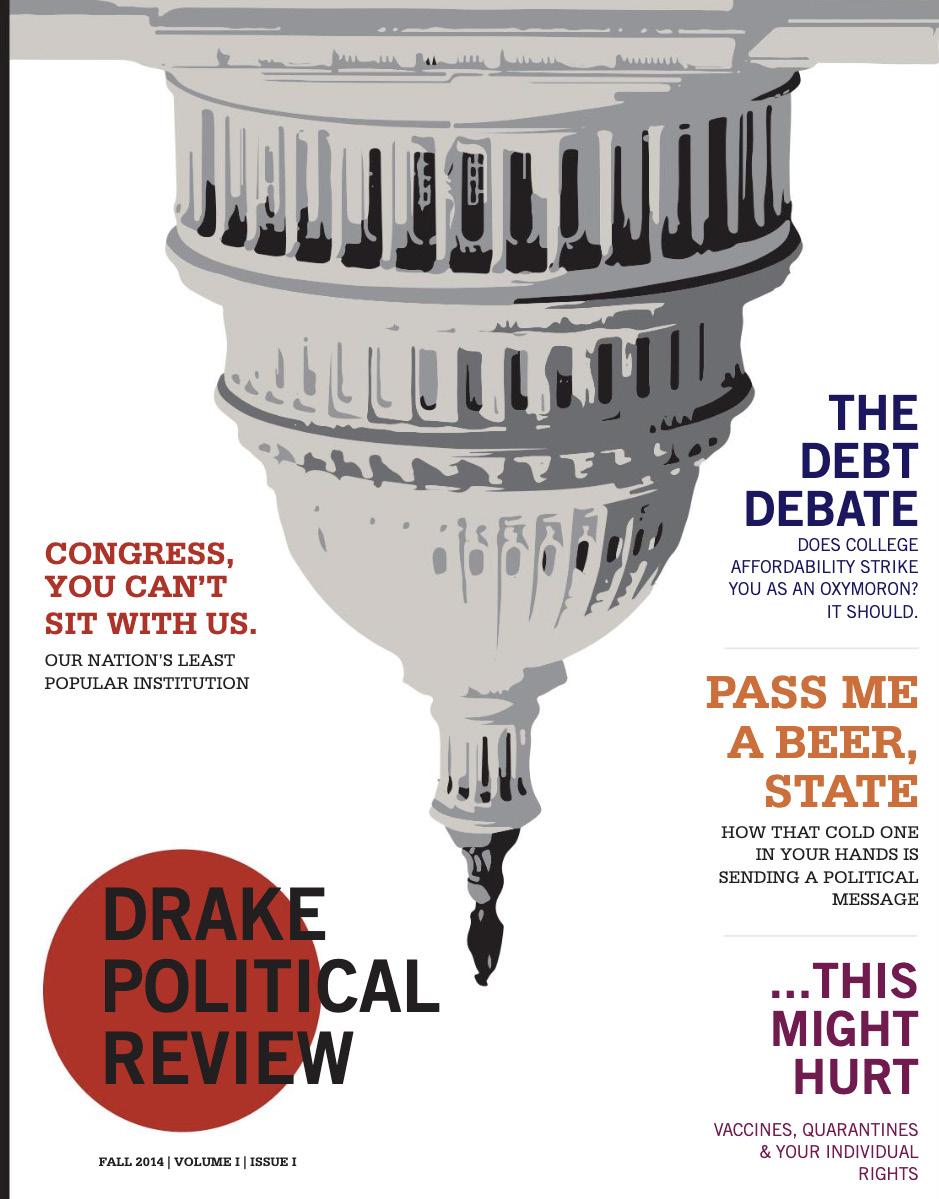









Dear Reader,











Dear Reader,
Editor-In-Chief
PARKER WRIGHT
Art Director
TYLER STRACHAN
Assistant Art Director
To say the last year has been stressful, anxiety inducing and has aged me 20 years would be an understatement. It has been said nonstop, but we truly are living in unprecedented times; we are experiencing history unfolding all around us.
Drake Political Review’s mission has always been to foster an engaging, nonpartisan environment for students of all beliefs to come together, civilly engage and stay informed.
Like many, the recent election has left me speechless; I’ve struggled to figure out what to write in this letter because of it. I’m not here to endorse any side, but it cannot be denied that what has happened is not just unprecedented — politics has been forever changed.
One thing is for certain: we are living through history. We’ve just elected the first felon to the nation’s highest office. That said, history and chaos are at the heart of this magazine. From Iowa reproductive rights to the war in Gaza to AI’s influence in politics; this issue dives into the different battles people are facing around the globe.
This issue would not be possible if not for our amazing team of writers, editors and designers. I want to give an extra shoutout to Tyler, our art director, who has been by my side throughout this entire process. She has kept me sane and has done amazing work designing this issue. I owe her an unpayable debt of gratitude.
The uncertainty going forward means the need for journalists to continue to tell these stories and highlight the chaos is more imperative than ever. Without us, the truth doesn’t get out. We will not be threatened or silenced, we will continue to do our jobs and hold our leaders accountable.
Now, without further ado, turn the page and…
LETS TALK POLITICS!

EMILY ZELLER
Assistant Designer
EVE LOEHRER
Staff Editors
NORAH JUDSON
JACK MALINSKI
EMILY VOLLMER
Assistant Editor
ARRAN DAVIS
Photography
SARAH FEY
Contributors
CAROLINE SIEBELS-LINDQUIST
AVA CARY
ARRAN DAVIS
MARISSA DICKINSON
BEA GOODMAN
MARGARET GORHAM
JACK HARRINGTON
MORGAN HOWTON
NORAH JUDSON
VANISHA KRISHNANI
OLIVIA KUFFEL
EVE LOEHRER
ELLIOT NELSON
RILEY PALMER
SOPHIA ROBERTS
KIRA SCHALL
MACK SWENSON
JOSIE THOMPSON
JOELLE WEBB
PARKER WRIGHT
Faculty Advisor
JENNIFER GLOVER KONFRST
1st Place Best Magazine Cover
PAIGE MINOR - FALL 2023 ISSUE
1st Place Best Editorial Illustration
PAIGE MINOR - FALL 2023 ISSUE
Honorable Mention Best Headline
EMILY ZELLER - FALL 2023 ISSUE
3rd Place Best Magazine News Page/Spread
PAIGE MINOR - FALL 2023 ISSUE
3rd Place Feature Magazine of the Year
MADELINE CRAWFORD - FALL 2023 ISSUE
2nd Place Best Magazine Entertainment
PAIGE MINOR - FALL 2023 ISSUE
2024 Pacemaker Finalist FALL 2023 ISSUE



the Change You Want to See!




Emily Zeller: For a Stellar Tomorrow, vote Stellar Today!



The DPR staff is running for office. Who will you vote for?
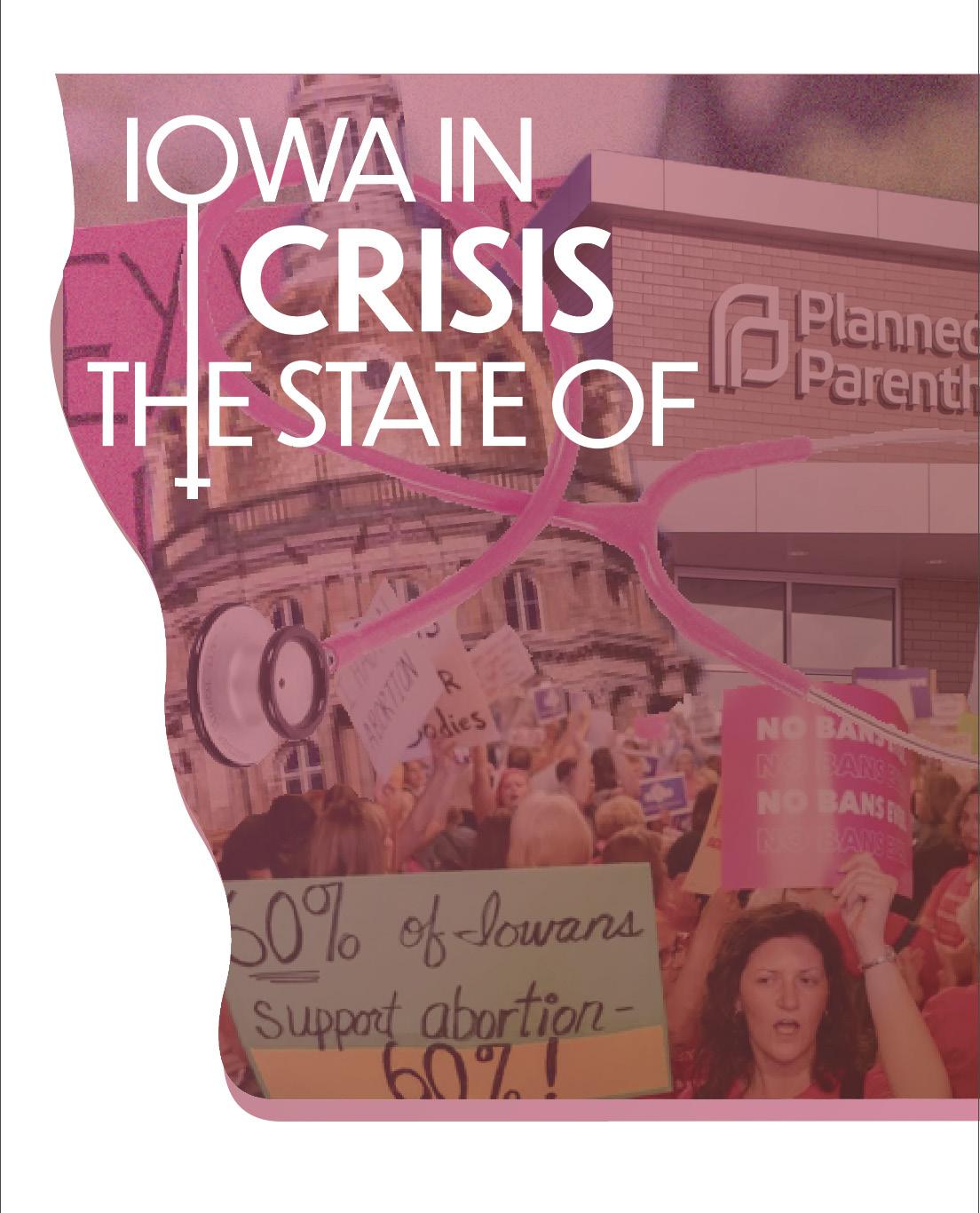
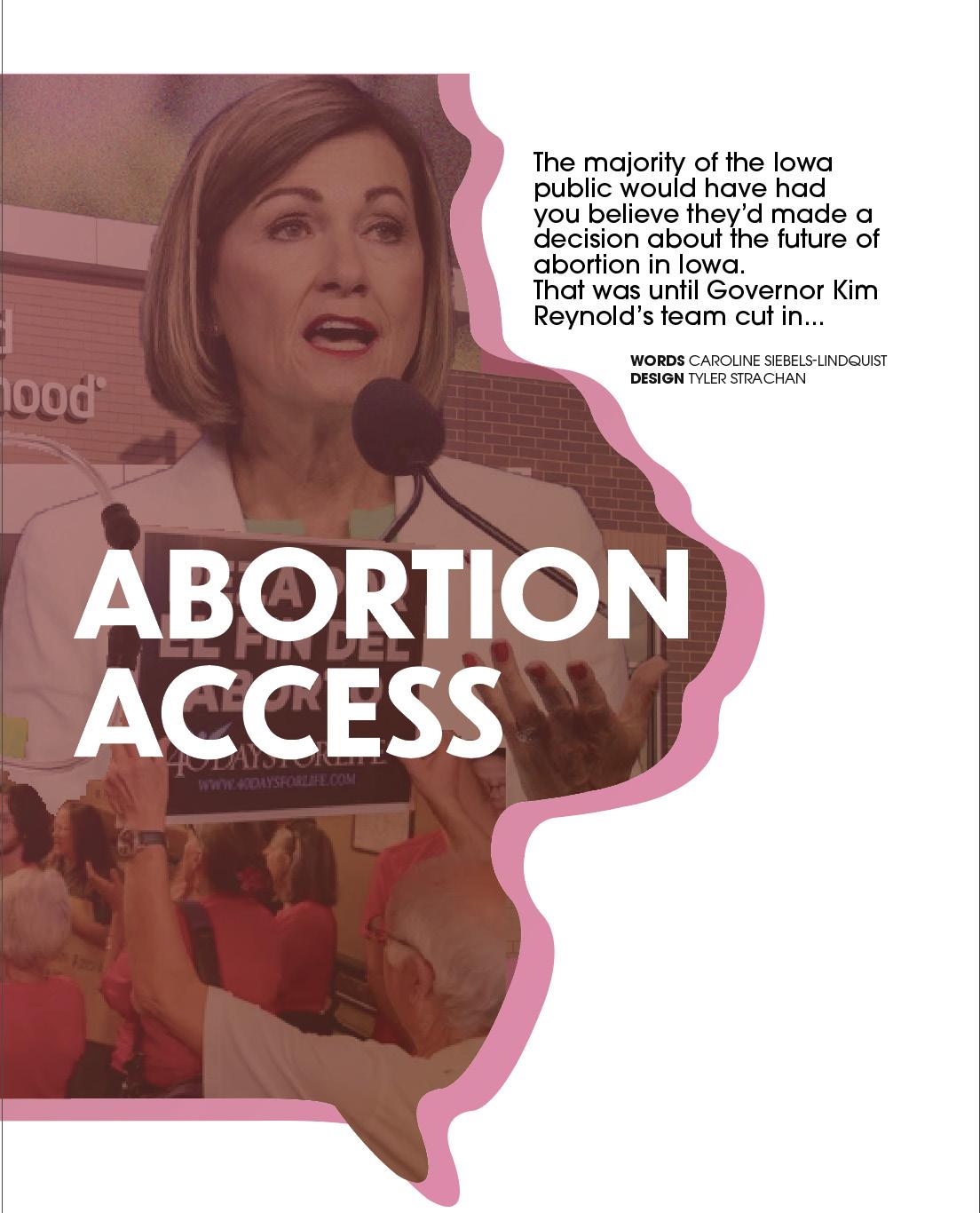
The
majority of Iowan’s
would have had you believe they’d
made a decision about the future of abortion in Iowa. That was until Governor Kim Reynolds and her team cut in.

here are few things as controversial in U.S. politics right now than abortion. It was one of voters’ top concerns going into the presidential, state and local elections. Iowa’s recent charge on abortion access claims the frustrations of the 64% majority in favor of reproductive rights, while others at and beyond the Capitol have rejoiced in its demise.
The legal battle between the Iowa Legislature and Planned Parenthood ended with a near-total abortion ban that went into effect on July 29 of this year, after a previous attempt to enact the legislation was stalled by the Iowa Supreme Court in the summer of 2023. Efforts by Iowa’s Democratic Party for a constitutional amendment to be on the ballot this election season, to ensure reproductive rights throughout the state, proved futile.
Despite its following of other anti-abortion legislation in states like Texas and Florida, Iowa is a leader when it comes to alternative legislative makeup, standing out from the rest of the U.S. These differences, alongside Gov. Kim Reynolds’ mission to restrict access, have led Iowa to its current near-total abortion ban.
Iowa’s legislature works in two-year cycles called general assemblies. In order for a question to join the ballot, it must pass two consecutive general assemblies, meaning twice in four years.
Mazie Stilwell, director of public affairs at Planned Parenthood of Iowa, says that since Iowa’s guidelines for getting a question on the ballot vastly differ from other states, the hurdles are that much greater to overcome in order to enshrine abortion access in the state’s constitution.
“There’s no amount of signatures, no amount of petitions that you can circulate to get a question on the ballot in Iowa,” Stilwell said. “It all
I would argue that it’s never been more dangerous to be a pregnant person in Iowa than it is today.
MAZIE STILWELL, PUBLIC AFFAIRS DIRECTOR, PLANNED PARENTHOOD OF IOWA
runs through our state legislature. Which makes these local elections even more important.”
Evidently, the Republican majority, who saw abortion access success in states like Kansas and Ohio, blocked Democratic attempts to get a measure on the ballot and protect abortion access in Iowa.
“They got scared and realized if they would have put [abortion] on the ballot, not only would it have turned out more Democrats in this election, but they would have lost,” Stilwell said.
Despite Stilwell believing abortion access to be an Iowan value, Iowa’s current legislation would make it seem otherwise.
“It was just a few years ago that the Iowa poll was showing that about 49% of Iowans support safe and legal abortion in most or all cases. That’s now up to 64%,” Stilwell said. “I think that’s a direct reflection of the direction that this Republican trifecta led by Governor Reynolds has taken us.”
But if the majority of Iowans support abortion access, then why does Iowa’s Republican majority consistently aim to hinder abortion access?
“Iowans really did not believe that abortion would ever be banned in this state,” Stilwell said. “We’ve been in this legal cycle since 2017, and [since then] abortion has been under threat, but the courts have saved us, rinse and repeat…So, [abortion] isn’t something that has to be driving their voting behavior because it’s not going anywhere. Fast forward and there we go. It’s now taken away.”

Now that Iowa’s voting pattern and once fervent support for Gov. Reynolds has culminated in its current anti-abortion state, Iowa is reaping the consequences of a near-total abortion ban.
“I would argue that it’s never been more dangerous to be a pregnant person in Iowa than it is today,” Stilwell said. “And people don’t want that, that is not the state that we want to be living in.”
The Inside Rep. David Young, serving in the Iowa House of Representatives in District 28, indicated that there are certain issues flagging voters this election cycle, as they do every election.
“Some issues come and go and some stick around election after election,”
Young said. “Some issues are black swans, some are consistently at the top of voters’ concerns, and some are harbingers.”
Young offered insight into the future of the Republican Party in Iowa.
“Republicans haven’t always been positioned in the way we are currently,” Young said. “This is not permanent. The Democrats held strongholds at one time, too. And that didn’t last forever. One has to be a realist and seek to understand party realignments and history to know how the political pendulum swings.”
Despite highly publicized partisan legislation, Young notes that Republicans and Democrats do undertake legislation together.
“Over 80% of legislation passed in the Iowa House is bipartisan,” Young said.
“When I served in the U.S. House of
Representatives there was a lot of bipartisanship and work done across the aisle in committees and on the House floor. Unfortunately, one only hears about what separates people and not what unites them.”
Connie Ryan, the executive director of Interfaith Alliance of Iowa, an organization that focuses on resisting religious extremism, called out attempts that aim to impede the inherent religious rights of others.
“The work of the alliance is broad, but the core work and mission of the organization is to protect religious freedom while also calling out when it is misused to harm people or take away people’s rights,” Ryan said. “Challenging extremism, usually religious extremism, looks very different depending on the issue, and reproductive health care is one of the issues that we tackle.”
Though the Interfaith Alliance of Iowa did not initially set out to protect abortion access, Ryan stressed the importance of curtailing religious extremism.
“[Iowa’s abortion law] goes far beyond the norm,” Ryan said. “It’s extreme in that it’s inserting one religious belief into public policy at the detriment of all people in the state.”
Though extremism may be subjective, Ryan makes her stance clear.
“For [Interfaith Alliance of Iowa] it is a matter of when somebody is using their faith, in this instance, conservative Christian faith, to limit the rights of other people,” Ryan said.
“[They’re lifting] their faith above other people’s rights, whether the other people are of faith or not, and [using] their agenda to take away people’s rights.”
Planned Parenthood of Iowa’s dream to see a ballot measure ensuring a bortion access is not likely to pass both Republican-controlled chambers anytime soon.
Anti-abortion efforts by the legislative majority go against Iowa’s previous reputation as a swing state. David Young doesn’t see Iowa’s evolving reputation as so black and white.
“Iowa may be coined a red state, but it’s not minted deep red as demonstrated by some of the data behind Iowa’s party registration in tighter districts and across the state overall,” Young said. “We’re closer to purple than people think and it only takes one election cycle to start demonstrating and showing it.”
While Iowa’s near-total abortion ban may lead some to believe its transition to scarlet borders is complete, Mazie Stilwell still has hope.
“It’s affirming to know that Iowans are with us, that the bubble that is the Capitol, which is currently ruled by anti-choice politicians and lobbyists, is not real,” Stilwell said. “It’s not reflective of how Iowans feel.”
Coming down the freeway into Iowa, drivers will see welcome signage that reads, “Freedom to Flourish.” While Iowa may be marketing its fields this way, there are many liberties not flourishing within the corn belt.
[Iowa’s abortion law] goes far beyond the norm, It’s extreme in that it’s inserting one religious belief into public policy at the detriment of all people in the state.
CONNIE RYAN, EXECUTIVE DIRECTOR OF INTERFAITH ALLIANCE OF IOWA


Since emerging on the drug scene in the past decade, fentanyl has wrought havoc on communities and families, including here in Iowa.
WORDS MACK SWENSON DESIGN TYLER STRACHAN

magine a drug so potent that an amount equivalent to half a grain of rice is deadly, so dangerous that it’s responsible for a majority of U.S. drug overdoses and so prevalent that most non-medical users don’t even know they’ve taken it. For millions of Americans, this is more than a terrifying thought experiment. It’s fentanyl.
Fentanyl is an extremely strong opioid — about 100 times stronger than morphine, which is why it’s often prescribed to people with a tolerance to less powerful opioids. Opioids — including morphine, heroin and fentanyl — activate the same receptors as endorphins, the body’s natural painkiller.
“I just needed something to chill out and relax,” said Stacy, a Des Moines resident who agreed to share her story on the condition that she go by first name only. “My kid was out of control all the time, and I started using heroin [at the shelter] because it was easy access, because you’re around it. There’s people there that are dealing even though they shouldn’t be. You can’t control everything.”
When someone purchases from a drug dealer, they typically know what they’re buying. This isn’t the case for fentanyl, which is tasteless, odorless and cheap to illicitly manufacture. For buyers, it’s often a question of what dealers to trust.
“When they tested [my partner] at the jail, he tested positive for fentanyl, this, that and the other, and he was surprised,” Stacy said. “And I said, ‘I don’t know why you’re surprised.’”
Even dealers may not know that their products contain fentanyl. Fentanyl is often added to heroin, cocaine or methamphetamine to compensate for a low-quality product.
According to Stacy, when she smokes these drugs using foil and a glass pipe, she says she can tell if they contain fentanyl or other contaminants. She’s suspicious of anything that “bloats up” her pipe or doesn’t burn the typical temperature for heroin or meth.
“The dealers themselves don’t know what’s in there, and that’s why I’m very cautious,” Stacy said.
Fentanyl test strips have also gained popularity across the country for helping prevent accidental fentanyl usage and overdose — but not in Iowa. That’s because Iowa code outlaws the use of FTS, which are considered “drug paraphernalia” because they “knowingly or intentionally and primarily…test the strength, effectiveness or purity of a controlled substance.” However, Iowans can still access FTS through the Iowa Harm Reduction Coalition, according to their website.
“[Fentanyl test strips] are not a legal way of mitigating things at this time. Our focus is really to have a comprehensive approach to addressing substance use crisis,” said Robert Kruse, the state medical director and division director of public health for the Iowa Department of Health and Human Services.
Sometimes, individuals can’t or don’t test for fentanyl, or the tests fail to catch fentanyl. In these cases, Narcan — the brand name for opioid-overdose reversing medication naloxone — can save lives.
“Most dealers [have Narcan] or will have somebody that’s on their way in case,” Stacy said. “It’s no joke, man, and you sometimes have to take people to the hospital after the fact.”
Administering Narcan often doesn’t eliminate the immediate danger of an opioid overdose situation.
“[The person administered naloxone] doesn’t know what’s going on, and they know they’re no longer high,” Stacy said. She added that adverse reactions to Narcan “happen often, not always” and depend on the condition of the person’s body.
Iowa’s Tele-Naloxone program, which allowed Iowans to have naloxone delivered to their door following a telehealth visit with a pharmacist, ended Sept. 30 of this year, but Iowa HHS still provides naloxone to agencies and businesses that serve vulnerable populations..
The U.S. has long had a complicated relationship with opioids, a miracle drug for those experiencing acute and chronic pain. Fentanyl emerged in the 70s, but abuse didn’t skyrocket until the late 2010s — starting in the medical scene before expanding to the general public. As a result, fentanyl overdoses have risen sharply since 2014.
Though it’s hard to estimate the number of Americans now addicted to fentanyl, the number of people who overdose suggests a mortifying reality.
In 2022, ‘fentanyl overdose’ was listed as the cause of death of 73,654 people in the U.S. — approximately equivalent to the populations of Sioux City, Iowa, or Plymouth, Minnesota. Since 2018, fentanyl has claimed the lives of over a quarter million Americans and was responsible for 70% of drug overdose deaths in the U.S. in 2022.
Based on 2022 data from the CDC, Iowa exhibits among the lowest fentanyl-related overdose deaths in the nation, recording 6.4 deaths for every 100,000 people.
However, reported data isn’t necessarily reflective of true overdose deaths. Kruse said fentanyl isn’t always included in toxicology reports, and families may hesitate to report fentanyl’s involvement in a loved one’s death due to stigma. Rural areas might also have fewer resources to collect such data.
Though fentanyl overdoses in Iowa could be underreported, geographic factors might contribute to a lower rate here than elsewhere.
“We’re in a central location with relatively lower population density that may limit the transit of these types of distribution networks for things like fentanyl,” Kruse said. He also said Iowa possesses “good prevention programs” that could contribute to a lower opioid overdose rate.
the consequences of fentanyl, the drug doesn’t just kill; it also traps people in cycles of addiction. Just recently, Stacy says she was offered fentanyl.
my dear friends, her daughter is addicted to fentanyl, and I’ve seen what she’s had to go through with her 22-year-old daughter,” Stacy said.
A few Iowa organizations are working to raise awareness of the fentanyl crisis and mitigate fentanyl’s harmful effects.
Last year, Iowa HHS hosted a campaign to raise awareness of counterfeit pills among young Iowans and their parents. Kruse said the campaign included partnerships with families affected by fentanyl to reinforce “how crucial it is to have an open conversation with youth about the dangers of these substances” — dangers like a potentially lethal dose of fentanyl, which the Drug Enforcement Administration found in 6 out of 10 fentanyl-laced fake prescription pills.
“These pills are being disguised as safe, familiar medications, but in reality, they can have high levels of fentanyl,” Kruse said.
To address the spectrum of issues related to opioid and fentanyl use, Iowa HHS began Your Life Iowa, which acts as a “single space” for Iowans to access a variety of behavioral health resources, Kruse said.
“Some of the traditional public health kind of work has moved into that behavioral health [area] because we know that a lot of linkages between mental health and substance use come together,” Kruse said.
Fear of prosecution may prevent some Iowans from seeking help for substance abuse.
“It’s treated as an addictive disorder that needs to be recognized,” Kruse said. “But at the same time, we recognize that these drugs are illegal and they’re illegal for a reason.”

ROBERT KRUSE, IOWA’S STATE MEDICAL DIRECTOR
Titles are disappearing from Iowa libraries. Here’s what to know…
Enacting book bans is, at its most superficial, placing restrictions on accessibility in education. Some believe that the content and materials being banned should remain out of reach in schools and libraries, and some believe in the accessibility of those resources. There are arguments on both sides. However, maybe more importantly, there should be an examination of what book banning is doing to the educational system. Curriculums are being affected and, subsequently, so are students and schools.
As with any debate, there are two arguments to this issue — both rooted in good intentions. In this case, the two sides encompass those who believe book banning is constitutional and necessary, and those who don’t.
Groups who believe in book banning are generally supporting their argument on the basis of the protection of their children. They have a desire to keep inappropriate content and language out of reach. So, they challenge books that seem to imply or explicitly contain sexual content and certain sociological points of view.
A variety of people and groups are challenging books but, according to the American Library Association, parents challenge materials more than any other group. Iowa Attorney General Brenna Bird released a statement on X (formerly Twitter) explaining that parents will fear what their kids have access to in schools when they aren’t around.
Those who are against book banning generally see it as an encroachment on the First Amendment. This argument is rooted in the freedom of expression, according to the ALA. The government shouldn’t prohibit materials based on society’s idea that something is offensive. Placing a restriction on free thought and free speech is un-American.
An article by Education Week quotes Lambda Legal stating that students returning to school, especially those identifying with the LGBTQ+ community, are returning to bullying and intimidation — and now, censorship, with the enactment of book bans.
In 2023, Senate File 496 was signed into law by Republican Gov. Kim Reynolds. This bill
requires public schools to remove books with “descriptions or visual depictions of a sex act,” excluding health and religious materials. It also prohibits instruction about sexual orientation and gender identity through sixth grade.
Originally, a federal judge placed an injunction on portions of the law, but in August of 2024, it was brought back to an appeals court of three judges who overturned the injunction, opening the case to further proceedings and reinstating the ban on such materials.
According to Education Week, the court claimed that the law is an “age-appropriate restriction on content.” The passing of this law has led schools to err on the side of caution when it comes to the removal of materials from their libraries. Schools have removed books such as Aldous Huxley’s “Brave New World,” Richard Wright’s “Native Son” and Toni Morrison’s “Beloved.”
In the debate over the passing of this bill, the state of Iowa made the argument that book bans are a form of government speech, giving them leeway to make content-based decisions. There are some inconsistencies with this point of view. Libraries contain works from other political philosophies such as Thomas Hobbes’ “Leviathan,” Plato’s “The Republic” or even Adolf Hitler’s “Mein Kampf.” If content control is a form of government speech, then they are incoherent in their own philosophies.
The state hasn’t historically had control over the removal of books, which gives support to the plaintiffs who are challenging the book ban. Lambda Legal represented the individual plaintiffs and stated that it was unfortunate the law was being enacted right before the new school year, but the plaintiffs were encouraged that the appeals court was agreeing with some of their arguments, according to Education Week.
“The appeals court acknowledged that our student clients have been harmed by the law and have the right to bring suit,” Lambda said. “The court also rejected the state’s claim that banning books in libraries is a form of protected government speech. We will ask the district court to block the law again at the earliest opportunity.”
Public schools are relatively constrained by governmental book bans. Most tend to err on the side of caution when it comes to removing books
from their shelves. There are also general concerns over whether students are seeing themselves represented in literature. Similarly, there are concerns regarding sexual content, and what is considered too explicit.
When it comes to the educators’ side of things, they must make the difficult decisions about curriculum — what happens when a book they have been teaching for years suddenly becomes banned?
Jeni Sondag is a seventh and eighth-grade reading teacher in Underwood, Iowa. Because Underwood’s district is so small, teachers still have a lot of say in what books they teach.
“They still allow teachers to have a choice, and they’re not just fully run by what the district says we’re going to do,” Sondag said.
So far, Underwood has not been explicit in the list of books that are banned from its classrooms. The librarians do have some restrictions on what they can stock — for example, Colleen Hoover has been removed from middle school shelves.
Conversely, Jamie Dee is a high school English teacher at West Marshall High School.
It’s part of history that is being skipped over and not discussed.
JENI SONDAG MIDDLE SCHOOL TEACHER
“We saw [the book bans] coming, with the legislation, but I didn’t think it was really going to happen,” Dee said. “I just couldn’t believe it.”
After the book bans were set in place, the administration gave a list of banned books that were to be removed from shelves in her classroom and in the school library.
“Then eventually, I was taking books off my shelves, and almost in tears,” said Dee. “...it made me feel [hurt], like our state doesn’t trust me to make choices for students.”
Of course, in speaking about book banning in schools, not only should educators’ perspectives be considered, but also students’. Books as learning tools are important in building a students’ awareness of real-world happenings. According to Dee, the more that students are exposed to, the
more informed they can be in their decision-making. But, some of the materials that expose students to these things are being taken away from them.
“What’s so odd and ironic about it is that my students don’t hardly even know [bans are happening,]” Dee said.
When she had the conversation with her class, Dee said that students were “offended” — almost “hurt” — by the idea that the Iowa Legislature could take such freedom away from them.
Dee discussed with her students the idea that, just because you read something, doesn’t mean the material is encouraging you to act in any one way. In fact, taking away the material takes away a chance to have a conversation with students about the multiple perspectives of a single issue that may be in a book.
Dee also referenced a letter written by Kurt Vonnegut to a chairman of the Drake School Board who banned books from his high school in 1973. Vonnegut’s letter suggested teachers should “expose your children to all sorts of opinions and information…they will be better equipped to make decisions and to survive.”
High school students will be more aware of what is going on with book-banning legislation and how it affects them, since they have a bit more autonomy in their education. However, it’s still important to consider how younger students may also be affected — and it’s for some of the same reasons high schoolers are.
As a middle school teacher, Sondag recognizes the importance of conversation when it comes to teaching content that may contain inappropriate topics. Because of the sort of books that are being banned, it comes off as racist or discriminatory. But, she says, “It’s part of history that is being skipped over and not discussed.”
For both Sondag and Dee, parents challenging their teaching materials has rarely been a problem — it has maybe happened once at each of their schools. Sondag said that their school took some books off of library shelves that fell into the category of sexually explicit — such as Hoover’s books. However, Sondag’s perspective was that “as long as moms and dads know what their kid is reading” it’s fine.
In Dee’s opinion, parents have every right to question materials or books that are being taught, but only in regard to their own children.
WORDS & DESIGN EVE LOEHRER
Although the effectiveness of campaign yard signs is debatable, especially in presidential races, many Americans on both sides of the aisle choose to stake their support for a candidate in their front yard. However, not all yard signs are created equal.
This is the beginning of a legendary presidential branding campaign. In this sign, Trump’s name, brand colors and slogan are tied together so inextricably that they can all stand alone. The design is also clearly American flag-reminiscent, featuring stars and the classic red, white and blue color scheme, keeping with the Trump campaign’s pillar of patriotism and his promise to “Make America Great Again.” While this sign is recognizable, it’s not as legible as it could be. The kerning in Pence is very wide and all of the letters are very flat and wide, which is difficult to read.
Very few changes were made between 2016 and 2020. For the 2020 design, the year at the bottom is bolder and therefore slightly more prominent. However, in both the 2016 and 2020 designs, the year at the bottom feels like an afterthought. If you’re going to include something, let it take up space. The only thing that puts the 2016 sign over this one is that “keep America great” doesn’t hit the same.
Trump has the recognizability advantage in branding when it comes to this election. He has kept the same color scheme, design and slogan over the more than eight years he’s been running for president, which means almost every single American will immediately know this sign is his. However, Trump did have another font upgrade this cycle, which boosted his design over the edge. This new font is bolder, takes up more space and feels more powerful, which reflects his impact on American politics.
This logo doesn’t have the strength and recognizability a political campaign needs. Out of context, those not familiar with Clinton’s campaign materials may not realize the logo is hers. Additionally, the rounded font and not using all capitals appears passive and is at odds with the sharp angles of the ‘H.’
These design choices do not paint Clinton as a strong candidate, especially in opposition to Trump’s strong, c onsistent branding. Could better branding have won Clinton the 2016 election?
In between two exceptionally lackluster presidential yard sign designs, the Biden-Harris campaign presented a formidable opponent to Trump’s iconic branding. This sign is careful to avoid the classic Trump colors while sticking to a patriotic red, white and blue color scheme. Making the ‘E’ red adds contrast and interest to an overall simple design. Additionally, the red ‘E’ carries over easily to promotional materials that use “Joe” instead. The sign also includes an easy-to-remember call to action, which gives viewers a convenient way to support the campaign.
Harris raised over $100 million within two days of starting her campaign and couldn’t hire someone to design a better logo? I know she had to throw her campaign together fast, but this looks like some intern designed it in five minutes. This is not a recognizable or unique design, but it does get points for readability. The bold, modern font coupled with the sleek navy highlights the campaign’s association with the Democratic party, but also Harris and Walz’ progressive policies.

“Let’s Talk Politics!” Those words marked the start of Drake Political Review. Those words — first written in the letter from the editor by co-founders and then co-editors-in-chief Brianna Steirer and Susanna Hayward — have marked what DPR has stood for and have been stated in every issue since the first that was published in the fall of 2014.
When DPR first released, Barack Obama was still president, Donald Trump hadn’t announced his run yet and Corona was only a beer.
DPR has covered local to national to international events, including on-the-ground coverage of protests and rallies addressing the most niche to the most controversial sides of politics. Establishing the success and size of the magazine we know today wasn’t always a smooth ride.
It was the summer of 2014, Brianna (Steirer) Zaiss — just done with her sophomore year at Drake University — was working an internship with then-Iowa senator Tom Harkin at his office in D.C.
While in D.C. she met another intern from Duke University who created the Duke Political Review magazine. Zaiss was then introduced to the founders of Stanford, Harvard and Cornell political reviews and really took to the idea.
“I [told] them that they needed some flyover representation here in the middle of the country, they have the east and west coasts [covered.] I mentioned I wanted to start Drake Political Review,” Zaiss said.
She was roommates at the time with a graphic design student named Susanna Hayward. When she pitched the idea for DPR, Hayward was instantly on board.
“We split the co-founder title. My side being more content, political insights and infrastructure of the publication. Her side was more design, printing and distribution,” Zaiss said.
The rest of the process wasn’t as easy. Zaiss and Hayward
Drake Political Review is celebrating its 10th birthday; take a look back at where it all began.

pitched the idea to the Board of Student Communications (the independent governing body that oversees and funds all of Drake’s publications) who were anything but impressed and rejected their bid to become a student publication.
As a last-ditch effort, they went to the Student Senate to try and get funding.
“We changed our pitch from becoming a publication to an organization. We agreed to host events and discussions and we did end up getting very minimal funding; only like a couple hundred [dollars,]” Zaiss said.
They had a limited unpaid editorial staff and only a few different contributors who had heard of the magazine through word of mouth.
“We didn’t have access to any of the BSC equipment, we had very little stuff of our own and definitely not the tools and programs you have today,” Zaiss said. “[Hayward] essentially hand drew the first issue, it was actually pretty impressive what she was able to do.”
In the end, after a semester of late nights and a plethora of hard work, they were able to complete and print around 150 copies of the first issue, thanks to a discount Hayward got from her job at the printing company.
The first issue turned out to be more of a success than they thought it would.
“It kind of blew up. I think then the BSC was forced to recognize us as a publication and bring us on fully,” Zaiss said.
By the second issue of DPR the following spring, they were officially registered as a publication and began receiving more funding. Zaiss credits DPR with getting her her first job after graduating in 2016.
Today Zaiss lives in the Twin Cities working for Hennepin County. Hayward currently works as the deputy art director for New York Magazine.
“I am so happy that DPR is still here 10 years later,” Zaiss said. “It makes all that initial work feel so worth it. I’m very pleased.”
WORDS MARGARET GORHAM
DESIGN EMILY ZELLER
PHOTOS SARAH FEY

Pelosi’s “Power” Paloma
4oz. grapefruit juice
2 oz. sparkling white wine
1.5 oz. tequila
1.5 oz. of lime juice
Salt (for garnish)
The former House Speaker known for her salty and strong personality is perfectly represented in this mixture.
Feeling parched? Bored watching a CNN Town Hall? Or just plain confused by a Fox News segment?
At Drake Political Review we’ve put together a menu of curated concoctions to try when you’re in need of some excitement or a break from the political atmosphere.
As equal-opportunity mixologists, DPR is here to share some bipartisan beverages with you!
McConnell Mule
1.5 oz. of bourbon
1 oz. of lime juice
4 oz. of ginger beer served in a copper mug
In need of a filibuster? Stuck in a filibuster yourself? Pour yourself a drink, it’ll probably be a while. Inspired by his own senate strategy, this drink brings a Kentucky twist to an originally Los Angeles-based cocktail.
Obama’s Shamrock
3 oz. of Irish Whiskey
2 scoops of vanilla ice cream
2 oz. of creme de menthe
Whipped cream
A shamrock (for garnish)
There’s no one as Irish as Barack Obama, save for Ayo Edebiri (The Bear). Lots of Irish songs like to blame their actions on whiskey and presidential candidates love to blame their problems on Obama, so naturally this pairing makes sense. A sweet yet strong cocktail to combat the bitterness of the rest of this menu, consider it a palate cleanser.
Trump Tower
Chicago Edition
4.5 oz. Malort
4 oz. grapefruit soda
Ice
A cicada (for garnish)
A staple of Chicago drinking culture, residents love to hate Malort. The wormwood liquor is often likened to burning rubber, bug spray, plain gasoline or all three combined. The Trump Administration often faces similar scrutiny in the media. While Malort alienates many, it is the favorite of others.
Trump fans are steadfast in their support of him and inspired by his speeches. One might argue that he alone could change the narrative about Malort.

Reagan’s Recall
0.5 oz. vodka
1 oz. white rum
0.5 oz. silver tequila
0.5 oz. triple sec
0.5 oz. simple syrup
0.5 oz. lemon juice
4 oz. Coca-Cola lemon wedge (for garnish)
When under scrutiny, it’s important to coordinate your answer and never admit to unnecessary guilt. A great neutral response is “I Don’t Recall,” a phrase that Ronald Reagan used a total of eighty-eight times during the Iran Contra Affair Trial. So whether you’re avoiding an admission of guilt in illegal arms deals or you had a Long Island Iced tea last night, it’s the perfect solution to your woes.
Tim’s ‘Ope’ Fashioned
1 orange slice
1 maraschino cherry
1 tsp cherry juice
1 oz. maple syrup
4 – 6 dashes bitters
2 oz. brandy
Ice
Lemon twist (for garnish)
As an Iowan publication, who doesn’t feel Midwest pride? As he likes to remind us, Tim Walz is everyone’s favorite neighborhood Midwestern and what better way to celebrate that than a brandy old fashioned? Typically the staple cocktail of Wisconsin supper clubs, our version features maple syrup to honor the voluntary Canadian status of our Minnesotan neighbors.
The Coconut Tree
3 oz. Malibu rum
2 oz. pineapple juice
A cookie straw (for garnish)
Tiny umbrella (for aesthetic)
Have you just fallen out of a coconut tree? Harris might’ve. The viral statement comes from when she discussed her upbringing at an education event while speaking to the press.
Biden’s America
2 oz. blue curaçao
5 oz. of aged wine
2 scoops of vanilla ice cream
Throughout the past four years, we’ve often heard this administration referred to as Biden’s America. But what does it mean to be part of this America? Are people drinking Budweiser on Tuesday nights? Is the general public singing the national anthem at karaoke bars? We may never know but this drink features red, white and blue components so everyone can feel like a true American.
After presidents leave office, it is clear that they cannot pursue a “normal” life ever again. They will be recognized in places everyone else frequents; going to grocery stores, movie theaters and restaurants will inevitably become a hassle. This doesn’t even include the swath of Secret Service members who will follow them and their families for the rest of their lives. Despite this, however, presidents generally have a standard they must follow: they cannot (or, more realistically, should not) gallivant around aimlessly. Americans expect their presidents to pursue something noble or philanthropic following their service. Noble pursuits include John Quincy Adams’ tenure in the House of Representatives, William Howard Taft’s term as a Supreme Court Justice and Jimmy Carter’s experience as an activist and diplomat.
In contrast, some presidents pursue personal interests: Barack Obama, for instance, created Higher Ground, a media company that recently produced the film “Leave the World Behind.” This variety indicates the United States’ voter population’s disinterest in what former presidents pursue.
While Americans hope they won’t do anything wholly embarrassing, there are no firm “rules” for what they do. From a more realistic perspective, former presidents are entitled to do whatever they so choose.
Early presidents certainly set the standard for what later presidents pursued. George Washington, the clearest example, retired after two

The standards we set for former presidents and why there is no right or wrong.
WORDS ARRAN DAVIS DESIGN EMILY ZELLER
terms and lived a peaceful and private life at Mount Vernon. For most presidents, privacy is ideal, even if they sponsor organizations or use their background to promote other causes.
Outside of presidential libraries, former presidents are not forced to endorse or be the namesake of philanthropic or educational organizations. For many, however, that is what they choose to do.
The Clinton Foundation, for instance, works on climate change and global health. Many presidential foundations work with similar themes; for example, the Obama and Carter Foundations tackle related causes. These organizations promote world peace, international cooperation and ultimately expand the United States’ sphere of influence.
Perhaps the most well-known instance of a president’s pursuit after office is of Jimmy Carter. Carter, who was president from 1977 to 1981, developed an organization called the Carter Center after his term.
The Carter Center’s goal is to “prevent and resolve conflict, enhance freedom and democracy, and improve health.” This mission demonstrates his highly philanthropic nature, especially when combined with his efforts alongside Habitat for Humanity.
Some people see Carter as the embodiment of what former presidents should do; nonetheless, his work is not the blueprint of what presidents must do.
Despite the appeal of philanthropic or notable work, presidents also have the freedom to do whatever they so choose. Some choose to be authors (such as Hoover and Clinton), and others enjoy lighthearted hobbies such as fishing or, in the case of Truman, going on cross-country road trips.
There is a clear appeal to a simple and private life — after living for years in the limelight, many people would want to rest with their family and friends. Despite this, their names will still top newspapers and magazines, and their lives will never be truly their own.
Ultimately, what people decide to pursue after their years of service is entirely their own decision. They can write books, travel the world, begin philanthropic endeavors or whatever else they desire. While Americans are not necessarily indifferent to what former presidents put their names on, it is important to realize that they are people too.
Many people derive life lessons from former presidents; they aspire to their success, power, notoriety or fame. What people should not forget in this endeavor is that there is not one path to greatness, nor is there one right choice when it comes to life’s pursuits.
How women are shaping the future of politics.
omen have been treated differently than men since the dawn of time. A woman’s role was to stay at home, have children and cook for her husband. Today, we still see far too many instances of women being treated unfairly in comparison to men, especially when women try for a position of power. The pervasive sentiment has been that women should not be in those kinds of positions because they are too emotional and thus not strong enough.
Kamala Harris’ political campaign had drawn some much-needed attention to women in politics. Her campaign proved that you can successfully run a campaign while running a family.
With that being said, it is important to highlight the differences between Kamala Harris’ campaign in 2024 to Hillary Clinton’s campaign in 2016; because the way these campaigns were run shows that embracing your femininity can be both a pro and a con.
Clinton ran her campaign noticeably differently from Harris. Clinton’s campaign painted her as a woman who is on the front lines fighting with the men. Clinton seemed almost stone-faced, fully and abrasively opposing female stereotypes. Harris, on the other hand, has chosen to use her femininity as a

weapon in the political battle for president.
The obvious differences between these two women’s campaigns can be seen through looking at their rallies and debates. In Clinton’s first debate against Donald Trump in 2016, she did not make much eye contact nor show much emotion when facing off with Trump.
Clinton’s demeanor was a stark contrast to Harris’ verbal sparring match with the same opponent. Vice President Harris made eye contact with Trump the entire debate and used her emotions and facial expressions to her advantage.
Despite their differences, Clinton and Harris both aim to show the world that women can do anything. These women are providing a gateway for future generations, teaching young girls that societal gender stereotypes do not have any bearing on their capabilities.
Inevitably in a patriarchal world, both candidates received a lot of hate for pursuing a “man’s job.” Harris faced more sexualization than Clinton, even facing allegations that she slept her way to power due to her brief relationship with Willie Brown, the mayor of San Francisco.
Recently, people have deemed Harris not “woman enough” since she does not have any biological children despite her male counterparts not facing similar criticism or analysis of their personal lives.
On top of the battle for recognition as legitimate politicians, women in politics must also manage the extreme polarization in America’s two-party system. This challenge is true across all genders.
Jason Menke, the president of the Urbandale School Board, described the partisanship even in his local education campaign. He tried to run as a concerned parent but soon realized he had to shift his strategy.
“The first question out of their mouths was, are you Republican or Democrat?” Menke said.
Some are concerned that women in politics are too emotional to face this kind of polarizing conflict. Menke thinks otherwise.
“I mean, all you have to do is go on Truth Social and look at the former president’s rants in all caps to recognize that

emotional intelligence is not something that is driven by gender,” Menke said.
For Laura Snider, a former Iowa House of Representatives candidate, unequal treatment is just a fact of the job as a woman politician.
“There’s always kind of a stigma to women which is if you work hard and you work a full-time job and you also have a family the first question people ask is, how do you do it all? That same question is never posed to men,” Snider said.
As a reflection on the impact of seeing women emerging in strong political positions, Snider is left hoping that future generations of women won’t shy away from their dreams.
“I would just encourage younger girls to not have to be asked to know that there is a place for them and their voices are important, and they should be heard,” Snider said.
Women have never been treated equally in politics. They are deemed too emotional or too weak; but, women need to prove to the world that their voices are important and that they can make a difference.
Clinton and Kamala Harris are showing young women that they matter and they can be the ones to make a change in our society. In Harris’ words, “You are powerful and your voice matters.”
While the president often takes credit — or blame — for economic conditions, the true drivers of the economy lie far beyond the Oval Office.
WORDS JACK HARRINGTON DESIGN TYLER STRACHAN
Oh, the economy — what a fun topic that everyone understands so well. Add the president into this equation and people understand it even more. So, that is what this is all about?
The president is often judged based on the economy’s performance, but how much does the president affect the economy? It is clear currently, with the 2024 election, that the economy is a central talking point for many. It is one of the issues candidates are being judged most heavily on — inflation, unemployment, GDP, gas prices — but the question is, does the president have anything to do with those economic aspects?
The easy answer is no, but it’s easy to blame them or hail them for those numbers.
While every other guy at Starbucks is clearly an expert economist and tells you how you must vote, you need to understand that they probably do not know what they are talking about; the president is not the only factor that
determines the state of the economy.
“People give the president way too much credit or blame for what happens in the macro economy,” economist Sean Severe said. “The role of the president in terms of the economy overall is much smaller than someone would imagine.”
Severe is a professor of economics and a public speaker with a Ph.D from the University of Oregon whose expertise includes macroeconomics, monetary economics and econometrics.
Some of these misconceptions come from stereotypes or a lack of knowledge about how the economy works.
For example, since 1949, average GDP growth has been faster by 1.2% under Democratic administrations than Republican, and annual job growth has been 2.5% under Democrats while it has been less than 1% under Republicans. The numbers say Democrats are better for the economy, but many people will say the opposite. Who is better for the economy? The answer is that various other factors play a role in deciding what is “good” for the economy.
Candidates overemphasize their wins, and they diminish their losses. That’s something that is just part of the political process.
SEAN SEVERE, ECONOMIST
The President Isn’t the Only Part of Government? Really?
“Candidates overemphasize their wins, and they diminish their losses. That’s something that is just part of the political process,” Severe said. “
Economists call that the political economy.”
It must not be forgotten that the executive is not the only branch of government. The legislative branch is arguably just as, if not more important, than the executive branch regarding the economy.
“There are things that the government overall can do to change the economy, but most of that would require federal dollars, which would have to come from Congress,” Severe said. “So, the president has the authority to say ‘I want this done,’ but Congress holds the purse strings, so it’s ultimately Congress with the president who kind of guides the fiscal policy of our economy, not the president alone.”
Congress has the power of budget and appropriations, meaning they control the federal budget, deciding where and how the government spends its funds. So, when “spending bills” are in the news, and the government is on the verge of a shutdown, this is what they are talking about; this is when Congress can’t come together to decide where federal funds are going.
Not to mention that Congress also holds the authority to set tax rates; no need to explain how that affects the economy.
When looking at formal government institutions, many play a role in the economy, most famously, the president with the executive branch, Congress with the legislative branch and the lesser-known Federal Reserve.
Many people who do not know much about economics or government may not know what the Federal Reserve is or what it does. Still, the Federal Reserve plays a crucial role in the lives of all Americans.
“The Federal Reserve has much more power and authority over the economy than specifically the president. The Federal Reserve meets four times a year to determine what should happen with interest rates,” Severe said. “That doesn’t necessarily steer the economy but acts more as being like a subway car in that the tracks are already laid by groundwork done in years past, and the Federal Reserve decides whether we are going too fast or going too slow on the tracks that we’re on. It doesn’t have much ability to navigate and turn, but it can go too fast and cause the economy to crash with high inflation, or it can go too slow and cause people to be late, and we would see high unemployment, job losses, or recession.”
Congress established the Federal Reserve in 1913 to address banking panics. They made it to act as the central bank of the United States.
The presidency has an impact on the economy, there is no doubt. What must be remembered, however, is that the president does not set gas prices, nor do they decide what the inflation rates are. They do not determine how much a dozen eggs cost, and they certainly do not hire people to lower unemployment.
The Federal Reserve has much more power and authority over the economy than specifically the president.
SEAN SEVERE, ECONOMIST

GOP voters and leaders lined up to vote in support of the Democratic Party. Many former President Trump voters declared that Trump was “unfit for office” and a “threat towards our democracy.”
Over the past months, many endorsements have been made for the Democratic nominee, Kamala Harris.
“It’s not just Donald Trump. The issue is well beyond that at this point. [The issue is] Republican members who are willing to protest the results that are fair, are free and are willing to reject results,” said Rylee Boyd, the national spokeswoman of Republican Voters Against Trump. “The main thing that the Republican Party should do is to support our elections, not cast so much doubt on them when it’s clear there’s no reason to.”
America has witnessed a drastic change in one of its major
Americans who were once registered Republicans were second-guessing their decisions. The Republican Party has seen a growing shift. The party’s voters have made their disappointments public by saying how embarrassed they were to initially vote for former President Trump.

transformed remarkably. First, it formed in the North, and Republicans controlled most of the northern states during the Civil War. Due to growing tension on slavery, they quickly became abolitionists who fought against it while the Democrats — heavily rooted in the South — fought to keep slavery present.
administration that the ideologies of the GOP shifted to what would be considered “modern-day Republicans.” They disagreed with the ideas of the New Deal, arguing that it interfered with Americans’ business interests and gave more control to the
Today, there is an echoing similarity in governmental principles, specifically in the economy and wealth. In contrast, former President Trump, despite being a wealthy figure himself,
“Trump kind of changed the modern trajectory because he came in and said, ‘Look, this is what we need to do. We need to do this for the working people,’” Hagle said. “It always struck people because here’s this guy that’s a billionaire, and yet he seems to resonate with people that are classified more or less as



“It’s clear that Donald Trump is running for himself. He’s running to keep himself out of jail,” Boyd said. “He has this dark, dystopian vision for a second term focused on getting revenge and retribution on his enemies. In contrast to Kamala Harris, who’s running for the American people, who wants change.”
Prior to the election, several well-respected Republicans opened up about why they did not choose to vote for Trump. These individuals brightly expressed their support for Harris as they believed she was the best candidate for the presidency.
Daughter of former Vice President Dick Cheney, who served under former President George W. Bush, endorsed Harris during an event at Duke University. The former Republican congresswoman was the vice chairwoman on the committee that investigated the Jan. 6 attacks that led Trump to the Justice Department for prosecution.
The former VP of the second Bush Administration joined his daughter in voting for Harris. Cheney said that Trump tried to steal the 2020 election using lies and manipulation. He also believes Trump kept the power after voters rejected him and believes, as citizens, “it is our right to defend our Constitution to protect our democracy.”
Before the Jan. 6 insurrection, Grisham was a White House press secretary under Trump and chief of staff to former First Lady Melania Trump. Regarding Harris, Grisham said, “Kamala Harris tells the truth. She respects the American people and she has my vote.”
“A lot of GOP voters wish to go back to the party of Mitt Romney [and] Paul Ryan. There’s not [a Republican presidential candidate] that immediately jumps to mind that people have brought up as a leader of the party post-Trump,” Boyd said. “Even if Trump is defeated in November, I think it’s unlikely that he will completely go away from the Republican Party.”
What will the Republican party look like in the future? In the simplest terms, the best way for a GOP nominee to gain a unified Republican base is if Trump is not the frontman for their party.
For Republican voters, the 2024 election results reflected divisions between and within parties. President-elect Trump is headed to the White House without the full backing of his own party. How and if he hopes to unify Republicans waits to be seen.
It’s clear that Donald Trump is running for himself. He’s running to keep himself out of jail.
RYLEE BOYD, NATIONAL SPOKESWOMAN OF REPUBLICAN VOTERS AGAINST TRUMP.


Politicians have style too and they aren’t afraid to show it.
Certified Cali girl Kamala Harris doesn’t see a problem with it. From rallies to the cover of Vogue, Harris’ love for her classic Converse Chucks is well documented. Harris’ style has subtly diverged from the traditional power suits that have been the uniform of women in politics. Harris and her stylist, Leslie Framar, have explored a mix of femininity, professionalism, and a hands-on attitude in her style on the campaign trail. Harris typically opts for a custom Chloe suit, statement necklace, flowy silk press and trusty Chucks.
The New Midwestern Princess Scoot over Chappell Roan, a new Midwest Princess is in town! The current governor of Minnesota and vice presidential pick for the Harris campaign is taking the internet by storm for dressing just like everyone else’s father in the Midwest. Tim Walz has that working-class appeal and “Big Dad Energy” that many have been craving. He’s here to take back the camo hats and the country. Walz doesn’t need a stylist when choosing his outfits; he can be seen anywhere from rallies to the Minnesota State Fair wearing Carhartt jackets, bootcut jeans, loafers and a pair of sensible glasses.

The very recently expelled congressman turned wannabe micro-celebrity arrived at this year’s State of the Union ready to make a statement. George Santos, a former representative from New York, received a very icy welcome from former colleagues to match his very icy collar when re-entering the chambers this March. He wore a classic suit topped off with an extravagant crystal-encrusted collar. Was it giving Icon or that I con?

The Lady in Red Former First Lady Melania Trump was certainly on top of the “best-dressed list” at this year’s Republican National Convention. The Republican candidate’s wife arrived on the fourth and final day of the RNC dressed in Dior, a fresh blowout and her famous smize. Her classic Christian Dior bar suit, a style almost as old as her husband, was a striking true red color and featured a dramatic figure and sleek pencil skirt. Many speculate that the Dior was a nod to the French and the bar suit’s legacy of bringing on a fashion revolution.


These Boots Were Made for Walkin’... or Struttin’
The Governor of the Sunshine State’s boots have been the center of online speculation and debate. As Gov. Ron DeSantis struts across the stage in his signature cowboy boots at rallies and speeches all the people can seem to focus on is whether he is wearing lifts or not. Standing tall might seem minuscule but tall politicians represent a vision of confidence and power. DeSantis has denied gossip surrounding his boots and experts lack definitive answers to the claims. Maybe DeSantis is just here to slay the house down with his boots.
Nikki and Her Coat of Many Colors
The former Governor of South Carolina and United Nations Ambassador Nikki Haley arrived at the Republican National Convention looking to unify the party as a key speaker. The once-rival of former President Trump arrived in a periwinkle Teri Jon jacket dress featuring a colorful floral motif and a beautiful sheen with matching floral buttons. Her standout attire helped distance her from candidate status and repositioned her into a unified supporter of her party’s candidate.
She’s Still Got it!
The former First Lady Michelle Obama made her grand entrance into the Democratic Convention on August 20, 2024. The energy in the room filled as the crowd and her husband embraced her. Her look was nothing short of detailed and intentional. She delivered her speech in a Monse’s Resort 2025 navy blue power suit collection. Her jacket featured satin cutouts and a waist-cinching buckle giving her a futuristic feel to match her speech of envisioning the future. Her outfit was nothing short of detailed and intentional. The cherry on top was her waist-length knotless braided ponytail which marked her current era as a former first lady. She came to show she’s still got it.

25 years later, how one TV drama shaped thought and action in Washington.
A first-time viewer of the pilot episode of “The West Wing” will observe the sweeping shots tracking the interior of the White House as the story follows Chiefof-Staff Leo McGarry into an average day at work running the nation. Though the viewer is aware that this character is merely playing out a script on a set replicating the hallowed halls, and though this episode aired 25 years ago this September, “The West Wing” continues to influence fans’ political perspectives.
In his White House, Andrew Jackson had a big block of cheese for those who might be hungry. In this spirit of caring for the people, Leo McGarry delegated the staffers of the fictional Bartlet Administration to meet with those whose voices were hungry for open ears.
Though dreaded and derisively dubbed “Big Block of Cheese Day” by the main cast of senior staffers, each character left their cheese appointments with new perspectives; and each episode depicting these days highlights the worthwhile importance of upholding minority opinions.
These scenes represent many idealistic, if unlikely, events that Aaron Sorkin wrote into “The West Wing.” Yet this policy was actually adopted during the Obama Administration. The show
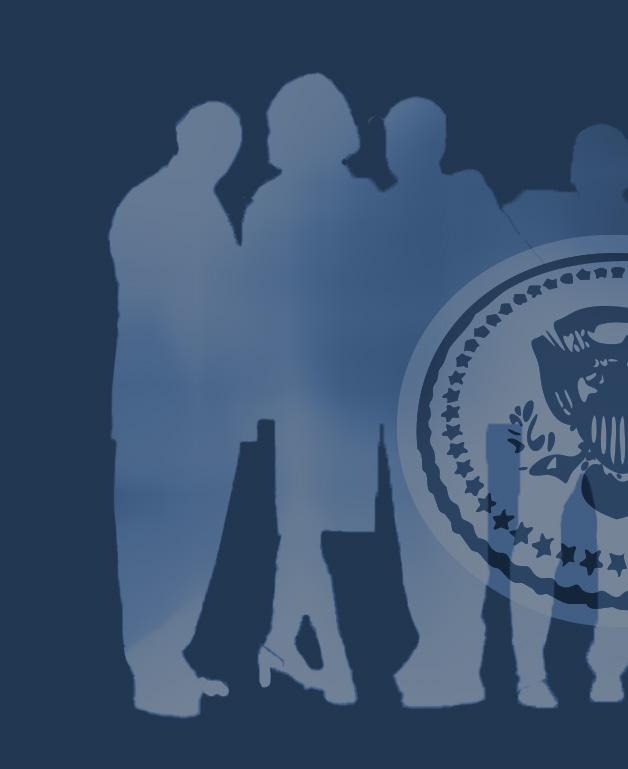
bleeding into reality is a concrete example of the impact of political fiction on political fact, even strong enough to reach the White House.
Art imitates life
Events in the two final seasons of “The West Wing” were very similar, almost prophetic, to the events of the 2008 election several years later. The character Matthew Santos was a young Democrat focused on healthcare access, and partially inspired by Barack Obama years before his presidential campaign had even begun.
Santos’ fictional opponent was Arnold Vinick, a moderate bipartisan Republican modeled after the late political legend John McCain.
Santos and Vinick were “The West Wing” writers’ ideal presidential candidates in 2004 and 2005, and then the 2008 election cycle saw the two powerhouses Obama and McCain as the respective nominees.
Even though television did not cause the 2008 election to happen this way, the writing of Santos v. Vinick as an unattainable fantasy only to have it manifested shortly thereafter shows that there is not a wide distance between Sorkin’s rose-colored glasses and the shades of reality.
No one gets left behind
The character Ainsley Hayes was a Republican lawyer who worked as an associate counsel for the Democratic Bartlet Administration. Despite
ideological differences, Ainsley defended and supported her coworkers, stating that even if someone thinks they’re “smug and superior” or that their “approach to public policy makes you want to tear your hair out,” Bartlet’s staff are not worthless, but “extraordinarily qualified, … righteous, … patriots.”
Bartlet’s Communications Director Toby Ziegler insisted that “government, no matter what its failures, … can be a place where people come together and where no one gets left behind, … an instrument of good.”
Odes to the potential of democracy are characteristic of “The West Wing,” as are the values of bipartisanship and civic duty. The sentiments enshrined in the show endure.
“Out of all the many massive hit shows I have worked on during my career [The West Wing] is the one that seems to span generations,” said costume designer Lyn Paolo. “The show appeals because we yearn for a truly decent person to lead the country, and the writing, direction [and] acting are all so very good that the show feels timeless.”
Zach Fisher, the Iowa Capitol Bureau Reporter at WHO 13 thinks political attitudes beyond this show are generally less glowing.
“People are really energized to get out and vote during presidential elections compared to midterms,” Fisher said. “School boards have become extremely politicized…usually they are nonpartisan elections.”
Faith in civic duty and bipartisanship is dismal. In 2023, the Pew Research Center found that 63% of Americans believe that all politicians run for office with the motivation of making money and 86% of Americans agree that “Republicans and Democrats are more focused on fighting each other than on solving problems.”
It is easy to fall into the cycle of polarization, cynicism and apathy that is born from negativity. But Fisher asserts that political “TV shows are really able to show the human nature” of politicians and reporters.
“The West Wing” has been criticized as an overly optimistic portrayal of this human element, but optimism is a virtue when engaging with politics.
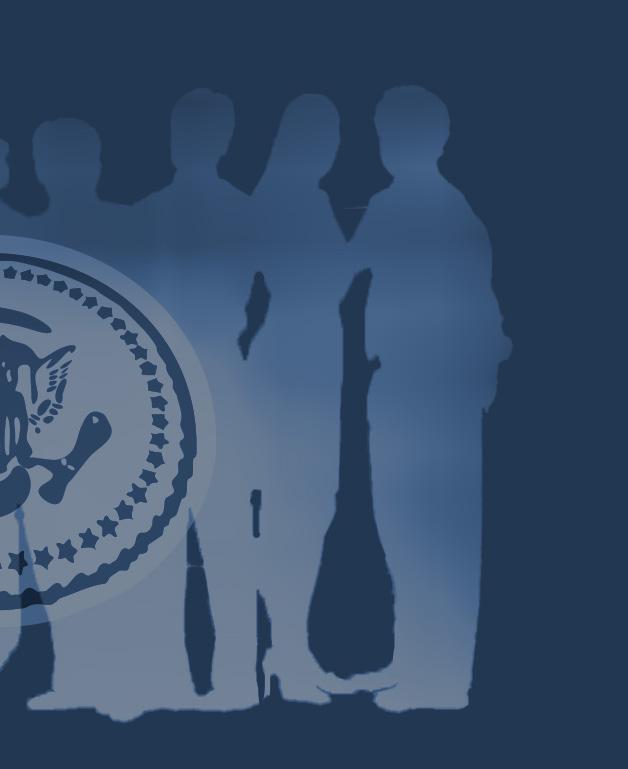
The show appeals because we yearn for a truly decent person to lead the country, and the writing, direction, acting are all so very good that the show feels timeless.
LYN PAOLO, “THE WEST WING” COSTUME DESIGNER
The impact that media can have is immense, whether it leads to policy, mirrors history or simply inspires emotion. College students must be mindful of the media’s influence to find a balance between Sorkin’s inspirational story and today’s political reality and enter into the world with cautious hope.
In the immortal words of President Bartlet, “This is a time for American heroes, and we reach for the stars.”
The rift between city politics and country politics is not as daunting as it seems. There are many reasons why the level of urbanization someone grew up in impacts their political preferences.
Many aspects of daily life vary greatly between urban and rural areas creating different value systems. What brings voters to the polls and what drives public policy come from different motivations. A different variety of issues create different concerns on voting day but these concerns all spring from the same place.
Morgan Township, Indiana County Councilman Andy Vasquez, a centralist Republican, says rural areas hold their own set of values, which are held at the center of rural ideas.
“We out here in Porter County in a rural area are very big on 4H; heart, health, hands and head is what it stands
for and it’s very much impressed on our young people,” Vasquez said. “Out here being part of a family unit is very important.”
This account of values-first politics is corroborated by Bob DeRuntz, a teacher from Porter County, Indiana, who ran for city council as a member of the Democratic Party.
“I think rural voters value less government and maintaining the rural lifestyle they chose to move to or remain in for their home,” DeRuntz said. “Their decisions at the ballot box are often driven by which candidate values small government, lower taxes and less development that encroaches on farmlands, wetlands or rural settings that they value in their lifestyle.”
Gillan Rosenquist, a Democratic city council member for Golden Valley, Minnesota, holds a different view.
Golden Valley is a first-ring suburb of the Twin Cities that Rosenquist describes as “a very solidly blue suburb” and that impacts what they focus on politically.
“Our suburb also has the largest gay
From silos to skyscrapers, there is one thing that unites us all… politics.
WORDS MORGAN HOWTON DESIGN EMILY ZELLER
and lesbian LGBTQ community-headed households in the entire state,” Rosenquist said. “So, LGBTQ issues and rights tend to be very important to folks in Golden Valley, [as well as] issues of inclusion, equity and protection of minority rights.”
Beyond differences in values, rural and urban individuals are facing very different concerns.
A rural individual will be thinking about their community and how they can sustain the land around them when thinking about pressing issues.
“We’re thinking about the infrastructure that we have in regards to roads, getting electricity to people,” Vasquez said.
Rural concern for infrastructure goes beyond party lines as Bob DeRuntz shares similar concerns.
“Porter County does currently have a dedicated funding source for quality road maintenance, resulting in a growing need for infrastructure investment across the county,” DeRuntz said.
Urban areas are facing a different kind of issue, however. The state of the economy is in question, and the concept of affordability is pressing on urban individuals.
“People are more focused on the price pressures of daily living, housing prices, in terms of affordability and also
being able to find homes,” Rosenquist said. “Particularly millennials looking for starter homes, affordable housing, particularly for people that make between roughly 50% and 80% of adjusted mediums can help, right?”
According to a 2023 study from the Pew Research Center, only 23% of Americans feel the economic conditions are good or excellent while 36% feel conditions are poor and 41% believe conditions are only fair.
Though these issues may seem unrelated, for many voters across the map, it all boils down to inflation. Prices of materials are making it hard to sustain rural infrastructure and the rising costs of living are making it hard to secure housing in urban areas.
The high cost of all items makes it hard for small areas to get the necessary funding to support the community. People in rural areas often live far away from jobs, hospitals and groceries, so good infrastructure is required to ensure people can live their lives.
In urban areas, the high cost of living increases crime and hurts housing security. Strong social infrastructure is needed to support those in the city that are in need of assistance. Things like homeless shelters, after-school care and stable policing are necessary to sustain the quality of life in urban areas.
The different issues and values of people from rural areas and urban areas have an impact on what political stances they have. However, where values may differ, concerns are connected; in that, all voters are connected.



A glimpse into the media since the tech billionaire took over one of the world’s biggest social media platforms.
WORDS JOSIE THOMPSON DESIGN EMILY ZELLER
When a rising trillionaire tweets, people listen. When a person can single-handedly disrupt an entire nation’s economy, governments listen. When someone says we are going to Mars in two years, the world listens.
Elon Musk’s words hold a lot of weight, and the many hats he wears have all propelled him into becoming the central political figure he is today. With his acquisition of X (formerly Twitter), Musk now has a firm grip on modern media.
This new shaping of public discourse, however, raises crucial questions. Is this platform fair? Ethical? Helpful or hurtful?
Over 65% of X’s users say they use the site to get their news, and Musk is currently in control of that. Will his legacy from now on be one of free-speech reform or plunge politics into chaos?
Musk’s acquisition of Twitter was not one anyone saw coming. What motivated him to give up $30 billion of his net worth to acquire a social media platform of all things?
Many assume it was for personal influential gain, but he has claimed that it is because he disliked the contributions it made in reducing conservative thought.
When Musk officially acquired
Twitter in October 2022, he fired 80% of its workforce and took the company private. In July 2023 he renamed it to X and became much more permissive with content regulations.
Posts are less likely to get taken down unless it’s illegal, and “Community Notes” have now been implemented for open collaborative fact-checking. Currently, the discussion has moved back and forth between whether Musk’s changes to X have caused more political polarization or if content regulation variation was what the media needed.
Many argue that the changes Musk has made to the platform may have positive effects, which is what the market was looking for.
“The fact that Musk bought Twitter is actually kind of a good thing, it argues in a way against the government regulating it because the market could do it itself,” said Professor Robert Miller of the University of Iowa College of Law. “If they’re all the same way, that creates an incentive for someone like Musk to go out and buy one and change it to serve a different part of the market. The fact that Musk has introduced a little more diversity into content moderation policies,
I perceive that as a good thing, not a bad thing.”
Miller touched on legal scholar Richard Epstein’s idea on the possibility of imposing FRAND (fair, reasonable and non-discriminatory) regulations into the media if Musk had not introduced competition in content moderation.
“Epstein suggests it should sort of be the same thing, we don’t want Facebook saying it’s okay if you speak here as long as you agree with us on blank. We don’t want that. We want them to take all views on a non-discriminatory basis. So you could impose FRAND regulations on social media platforms,” Miller said.
Tyler Rushing, a journalism professor at the University of Iowa and former journalist who is a frequent user of X, when asked about concerns about Musk’s differing content-regulation policies said, “You’re making it uninhabitable. There are people who have legitimate reasons for blocking people. A lot of journalists get harassed, a lot of women get harassed, a lot of people have stalkers. A lot of people want to enjoy and experience social media without having people they don’t want in their lives involved in it.”
Rushing believes Musk is taking away basic protections just so people can see
his tweets. He also believes Musk doesn’t truly care about free speech.
“They don’t really care about free speech for everyone, they just want to be really open about their bigotry, if it was truly about free speech, you wouldn’t be flagged for saying cis,” Rushing said.
Musk remains a mystery to most people, but X itself isn’t going anywhere anytime soon.
“Twitter is always going to have an audience because no other platform is giving you that real-time news and real-time sports and real-time politics like it,” Rushing said.
Miller also suggested that “It’s hard to see a world in the future where Twitter could ever be worth $45 billion anytime soon,” but also mentioned that Musk is not investing solely for the purposes of making money, he’s giving “value beyond pure financial volume.”
Musk’s ownership represents a pivotal moment that contrasts the way traditional media has flowed; many argue that this variety in our social media is necessary. How this tension unfolds will likely shape the future of public discourse. This responsibility lies not only on the owners of social media platforms but also is the collective responsibility of the users and how they use them.
They just want to be really open about their bigotry, if it was truly about free speech, you wouldn’t be flagged for saying cis.
TYLER RUSHING, JOURNALISM PROFESSOR AT UNIVERSTIY OF IOWA
aylor Swift, Kid Rock, Billie Eilish, Hulk Hogan and …. Bryce Hall? Whether you love them or hate them, the biggest celebrities of today have drawn the battle lines for the war that is the presidential election. Each presidential nominee pulled out all the stops, aiming to secure the most popular celebrities of our generations – and consequently their fan base.
Kamala Harris started strong with an endorsement from Olivia Rodrigo right after Biden dropped out of the presidential race. She only continues to strengthen her team of celebrities with endorsements from standout pop stars like Cardi B, Megan Thee Stallion, Charli XCX, Kesha and John Legend. Although this team already packs a punch, Kamala secured her arguably most powerful alliances in September with Taylor Swift and Billie Eilish.
Despite this stellar lineup, Donald Trump was not to be underestimated. Trump’s team started with an explosive endorsement from Hulk Hogan at the RNC. Kid Rock quickly took the stage, singing a rendition of “American Bad Ass” to show his support for the former president. Trump also received endorsements from big names such as Dave Portnoy, Jason Aldean and Chris Janson.
Along with these standout personalities, one of Trump’s strongest endorsements comes from an unlikely player:
entrepreneur Elon Musk. With massive fan bases backing celebrities on both sides of the battlefield, the election was a testament to the influence of pop culture on every aspect of our society.
In recent years, celebrities have grown increasingly influential in the political world. They draw attention to candidates, promote engagement and can even sway voters to one political party or the other. Seeing this, politicians have been pulling out all the stops to secure endorsements for the most popular celebrities, because while many citizens might not tune in for the debates or read political news articles, they will check their favorite celebrity’s Instagram or TikTok.
In their endorsements, celebrities often share helpful information such as links to voter registration – resources that an average person might not actively search out in their daily lives. Celebrity endorsements act as another weapon in the arsenal of campaigns.
In the wake of a celebrity endorsement, the news floods social media that America’s Sweetheart, the Most Eligible Bachelor or the Super Star athlete has picked a side in the battle. Not only is there an immense amount of media coverage of the initial post, but micro-news outlets on TikTok, Twitter and Instagram also pick up the story and run with it, further increasing the audience. People respond with support, outrage and shock, which draws attention – good and bad – to political candidates and the presidential election as a whole.
Tons of fans are instantaneously drawn into the battle that is the Presidential campaign, swaying the tides of who could win, which is why it is essential that candidates secure these endorsements and fill their army of supporters with as many Swifties, Eyelashes, Barstoolers and Hotties as possible.
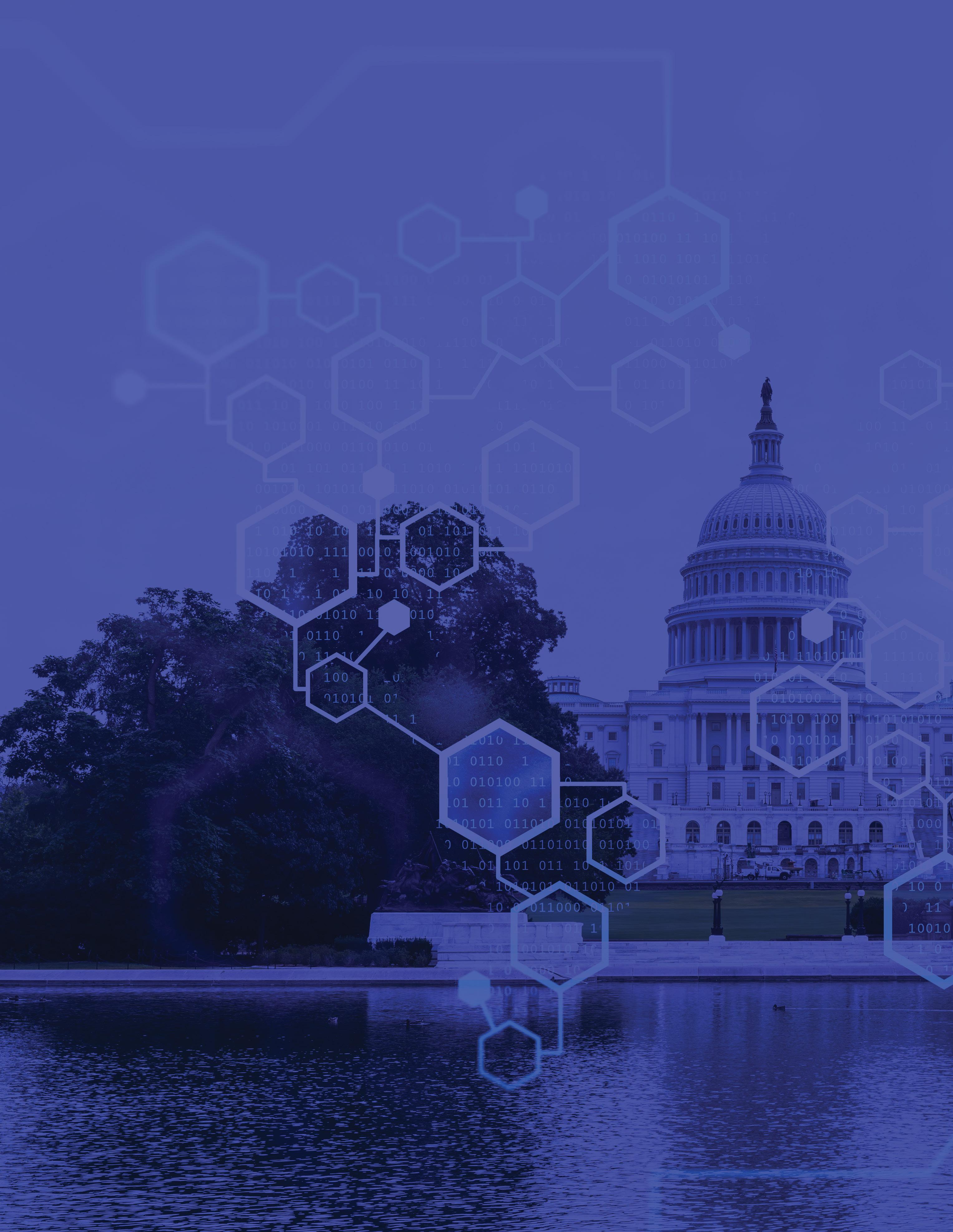
What the development of artificial intelligence means for the future of geopolitics.
WORDS VANISHA KRISHNANI DESIGN EMILY ZELLER
Not so long ago, artificial intelligence was an imaginary concept found in dystopian societies. Popular culture has frequently depicted AI as machines surpassing human control and government, mimicking human reasoning to such an extent that they surpass the human “masters” themselves. Now that AI has entered human society and is gradually becoming a part of our everyday life, this theme becomes even more important.
While society does not have to fear an AI-controlled government yet, we do need to look at how it is — or will be — affecting our governments.
Political Landscape of AI
AI is defined as machines that are programmed to emulate human intelligence.
Vidhi Ambwani, a data analytical engineer in Jersey City, New Jersey, simplifies it by explaining that AI builds its memory based on the data it’s given and refers to these systems as Large Language Models. In simpler terms, AI acts like a sponge in the vast ocean of knowledge; it retains water at command and releases what is asked of it.

We do not have to contemplate how AI can be used in a political capacity, as it has already been used for electoral manipulation. On Truth Social, an alt-tech social media platform owned by Trump Media & Technology Group, President-elect Donald Trump posted AI-generated images of Taylor Swift in mid-August 2024.
These AI-generated images sparked a controversy because this image portrayed the popular singer as endorsing Trump, even though she did not. Considering how vast her fanbase is, if she had not alerted people about this, Trump may have succeeded in swaying that impressionable base.
This raises an interesting question: what happens when AI develops to such an extent that human beings can no longer differentiate between what is authentic and what is not? Ambwani believes AI can be maneuvered to propagate misinformation and brainwash young minds, and also has the potential to complicate reality as we perceive it.
As the human race becomes increasingly dependent on technology, we also become more likely to believe the distorted reality AI will feed to society.
As it is now, governments are aiming to improve healthcare, transportation, the environment and benefit delivery through AI. However, it is well-established
throughout history that the primary goal of government and society has consistently been to ensure security.
After all, in every era societies have turned to technological advances to create more stability and security. With each era and every advancement, these creations have only grown to be more destructive.
So, what would happen if the government wants to move beyond these social welfare objectives and address security objectives through AI?
This technology possesses the power to augment conventional nuclear and cyber capabilities. This creates the possibility of an AI race very similar to the nuclear race during the Cold War era.
Security relationships among rivals may become harder to predict and manage with AI, as these systems act faster than humans, making their moves less predictable. Ahraz Husain, a computer engineer in Des Moines and Vice President of Growers Edge, believes that AI can be used to bring more precision to missiles and their attacks, therefore minimizing casualties and collateral damage.
Also, in traditional conflicts up until this point, the psychology of the opponent has been a critical focus point. AI has so far displayed limitations in assessing the human mind and how it functions. This begs the question of what would happen if two AI systems were deployed against one another.
Neither side is likely to have a precise understanding of the results of their interactions nor would they be able

to assume what the collateral effects could be. Until and unless the humane experience has been embedded in AI, its potential in warfare is only perilous ubiquitously.
While it may be difficult to predict how AI can change international security, one thing is certain: AI will be the bearer of myriads of changes.
The pace of the world was changed drastically once before with the invention of the steam engine. The Industrial Revolution profoundly transformed the economic, political and military landscape of the world. It also rearranged the global order wherein nations that possessed these new steam-powered technologies succeeded. AI also possesses the same capacities, if not more.
A new epoch is beckoning with these novel intelligence models penetrating our personal and political spheres. This technological development also possesses the power to create a new international order the same way the Industrial Revolution did.
The future of AI in politics may be slightly hazy now; however, as it becomes more intricately woven into the fabric of our human existence, it will undoubtedly revolutionize our world. AI is a double-edged sword and, at the end of the day, whether the future is bright or gloomy depends on the one wielding it.
So far, the public political figures wielding this tool have not displayed caution or sensibility. However, if future policymakers, bureaucrats and diplomats exercise caution and remain mindful of the potential positive and negative consequences of AI, we are likely to achieve an optimal political landscape.


WORDS OLIVIA KUFFEL DESIGN TYLER STRACHAN
In the days following the horrific Oct. 7 attacks carried out by Hamas against Israel, Israeli Prime Minister Benyamin Netanyahu declared war with the stated intention of completely destroying Hamas.
Since then, Israel has executed an indubitably brutal military campaign. Despite international condemnation, Israel justifies its ongoing actions as being rooted in security and counterterrorism concerns.
Failing to examine Israel’s actions through a counterterrorism lens subverts dialogue about their efficacy. Oct. 7 has become the rhetorical equivalent of 9/11. And it is critical that Israel not repeat the U.S.’s mistakes. But in the very first month, Israel had dropped more bombs on Gaza, a heavily populated civilian area, than the U.S. dropped on Afghanistan in a year.
Israel itself has confirmed that for every terrorist killed, at least two innocent Gazans are as well. It is clear that the status quo may be different than what Israel is leading people to believe.
Successful counterterrorism efforts combine a plethora of elements into a comprehensive strategy to disrupt terrorism at its roots from occurring and from spreading.
The U.S.’s National Strategy for Counterterrorism lays out critical avenues for counterterrorism, including diminishing terrorists’ capacity for overseas attacks; severing terrorists from sources of strength and support; eliminating terrorism’s ability to spread and radicalize; becoming more prepared; preventing terrorists’ access to Weapons of Mass Destruction; and working with private, public and foreign partners to prevent terrorism.
Soft power (use of influence or persuasion rather than force), too, is crucial. Aid to civilians, especially in an active war zone or densely populated area — Gaza is both — can remove terrorist organizations as a source of public support, alleviate poverty that
creates desperation — which terrorism feeds off of — and reduce resentment towards the invaders.
Moreover, funding local governments, implementing support programs and training ally forces to fight terrorism in local areas has proven an incredibly important part of good counterterrorism.
Finally, public opinion matters too. Israel has been subjected to harsh criticism regarding its incursion into Gaza. The United States, too, has come to be viewed in some countries as a foreign enemy because of mistakes made in previous counterterrorism campaigns. In these cases, public perception can do more than just garner resistance and condemnation — it can fuel terrorism by painting the ‘invader’ as a foreign enemy that needs to be stopped and face retribution.
Anyone not living under a rock for the past year is familiar with what Israel is doing in Gaza. Typically, it’s defended with assertions of the right to self-defense or the moral evil of terrorism. That isn’t disputed. However, it is worth disputing the efficacy of Israel’s current approach to counterterrorism for several reasons.
First, its reliance on raw military force is not ideal against a non-conventional actor. Second, it misses critical elements of a successful counterterrorism campaign, especially a ‘day-after’ plan. Third, it comes at far too high a civilian cost.
Firstly, Israel’s brute, militaristic approach has failed repeatedly. Its approach of “mowing the grass” — periodically conducting military campaigns in Gaza to deter militants — has existed for years, with examples as recent as 2014 and 2008. It is clear such a strategy does not work; each time, Hamas has rebounded after these military campaigns. It is past time that Israel finds another approach without killing thousands in the process.
Next, Israel’s current approach ignores several important aspects of counterterrorism. Many of those can be referenced with the list above, but
specifically without a day-after plan, Israel significantly widens its margin for risk.
Many speculate that this conflict will end with the Israeli occupation of the Gaza Strip; and considering that Israel’s government has ruled out allowing the Palestinian Authority to govern Gaza in the aftermath, it does not seem likely that Palestinian self-rule is assured. But without an alternative governing structure, Hamas will undoubtedly regain power in Gaza.
In fact, we are already seeing militants return to areas previously occupied by the Israel Defense Forces, further highlighting the flaws in Israel’s current approach. As that aforementioned U.S. source pointed out, without a plan, Israel will “continue military operations” in Gaza.
According to the source, without a humane and diplomatic framework for the future, Israel will never justify the immense damage it has done to families, communities or its own reputation.
*EDITORS NOTE: INFORMATION USED IN THIS ARTICLE WAS PROVIDED BY A UNITED STATES INTELLIGENCE OFFICIAL WHO HAS BEEN VERIFIED BY DPR STAFF BUT MUST REMAIN ANONYMOUS FOR LEGAL AND SAFETY REASONS.
Lastly, the price of Israel’s offensive is being paid in innocent lives and intense suffering. Aid trucks and ports are restricted, food and water are in short supply, electricity has been shut off and critical health and sanitation infrastructure has been destroyed. As a result, Gaza is facing famine and diseases and has been declared uninhabitable by the United Nations.
Thousands have died in airstrikes, raids, bombings and many more due to lack of supplies. A successful campaign to remove Hamas necessitates that meaningful steps be taken to alleviate the humanitarian crisis in Gaza.
Israel has declared it will not stop until Hamas is destroyed. But it needs to be evaluated what that truly means. Successful counterterrorism, as previously outlined, does not call for the total and complete annihilation of every militant, ideology and capability. Rather, it calls for the elimination of the terrorists’ ability to harm the homeland.
In context, Israel needs to ensure the goal is to eliminate Hamas’ ability to attack Israel. Maintaining the necessity of complete annihilation creates a slippery slope in which Israel justifies brute force and inhumane actions under the guise of counterterrorism when that goal is unattainable. Rather, by accepting an end to Hamas’ capacity to attack Israel, Israel opens itself to rebuilding Gaza, ending military operations and using soft power and covert operations to further dismantle Hamas, doing far more good than the status quo offers.
It is now a year into Israel’s invasion of Gaza in the ostensible pursuit of Hamas’ destruction, and Israel has yet to adopt a sound counterterrorism strategy, according to intelligence standards. Israel must reevaluate how it defines success in its current approach and adopt a strategy that prioritizes successful counterterrorism and alleviates the brutality of the status quo. Without a nuanced plan for addressing an adaptive threat, Israel will never be successful.

87% 68% 87%
17 OF 36 OF HOUSING UNITS DAMAGED 80% OF COMMERCIAL FACILITIES DAMAGED
HOSPITALS PARTIALLY FUNCTIONAL OF ROAD NETWORKS DAMAGED OF SCHOOL BUILDINGS DAMAGED

Political violence has blossomed in the shadow of the insurrection.
Political violence is on the rise in America, as is people’s acceptance of it.
A study conducted by the Public Religion Research Institute, released in October of 2023, found that 77% of the American people believed the country was headed in the wrong direction politically. The same study found that just under a quarter of Americans supported political violence as the election drew closer. Not only was support for violence rising in the United States, but reported incidents were too. A special report filed by Reuters in August of 2023 disclosed that political violence in the modern day was at the highest it had been since the 1970s, with one key difference. In the past, political violence was focused on the destruction of property to send a message. Today, the focus has shifted to a medium much closer to home: people
Building Bridges
“People are allowed to feel whatever they need or want to,” said Iowa House Rep. Rob Johnson. “But the truth is that you are not allowed to physically cause harm to people just because you disagree with them…We don’t have to agree, but we must respect each other.”
Johnson, a Democrat, ran for a House seat in HD34 in the 2024 election. His campaign centered around the theme of making Iowa “a better place for all.”
While on the campaign trail, Johnson encountered many voters whose beliefs were in direct opposition to his own. To him, those conversations were among the most important of his entire campaign.
“One lady [whose] door who I knocked on is a Republican,” Johnson said. “She looks at me, and she says, ‘You’re the first person to knock on my door in 12 years…because I am a registered Republican.’”
Johnson believes he may have gained that Republican as a supporter.
“She knew I was a Democrat, but me knocking on her door compelled her to come have a conversation,” Johnson said.

In the wake of events like the Jan. 6 insurrection and the multiple attempts that have been made on President-elect Donald Trump’s life, lawmakers on both sides of the aisle are questioning what the division in America means for the country’s future.
This sentiment was emphasized by Republican Congressman Zach Nunn, who currently represents Iowa’s third congressional district in the United States House of Representatives.
“There is no place in politics for violence,” Nunn said. “It’s time
to tone down the rhetoric in our country and realize more unites us than divides us.”
In other words, people are people, regardless of what makes them different — a recurring theme in Johnson’s campaign.
“I grew up in a time when we were told to keep our hands to ourselves back in the sandbox, in kindergarten, we were taught that,” Johnson said. “We’ve gotten away from that now.”
His solution to the rapidly growing discontent?
“We gotta get back to looking out for our neighbors… meeting people where they are, pulling people together,” Johnson said.
“You just have to be a human being.”
[The] truth is that you are not allowed to physically cause harm to people just because you disagree with them… We don’t have to agree, but we must respect each other.
REP. ROB JOHNSON, IOWA HOUSE
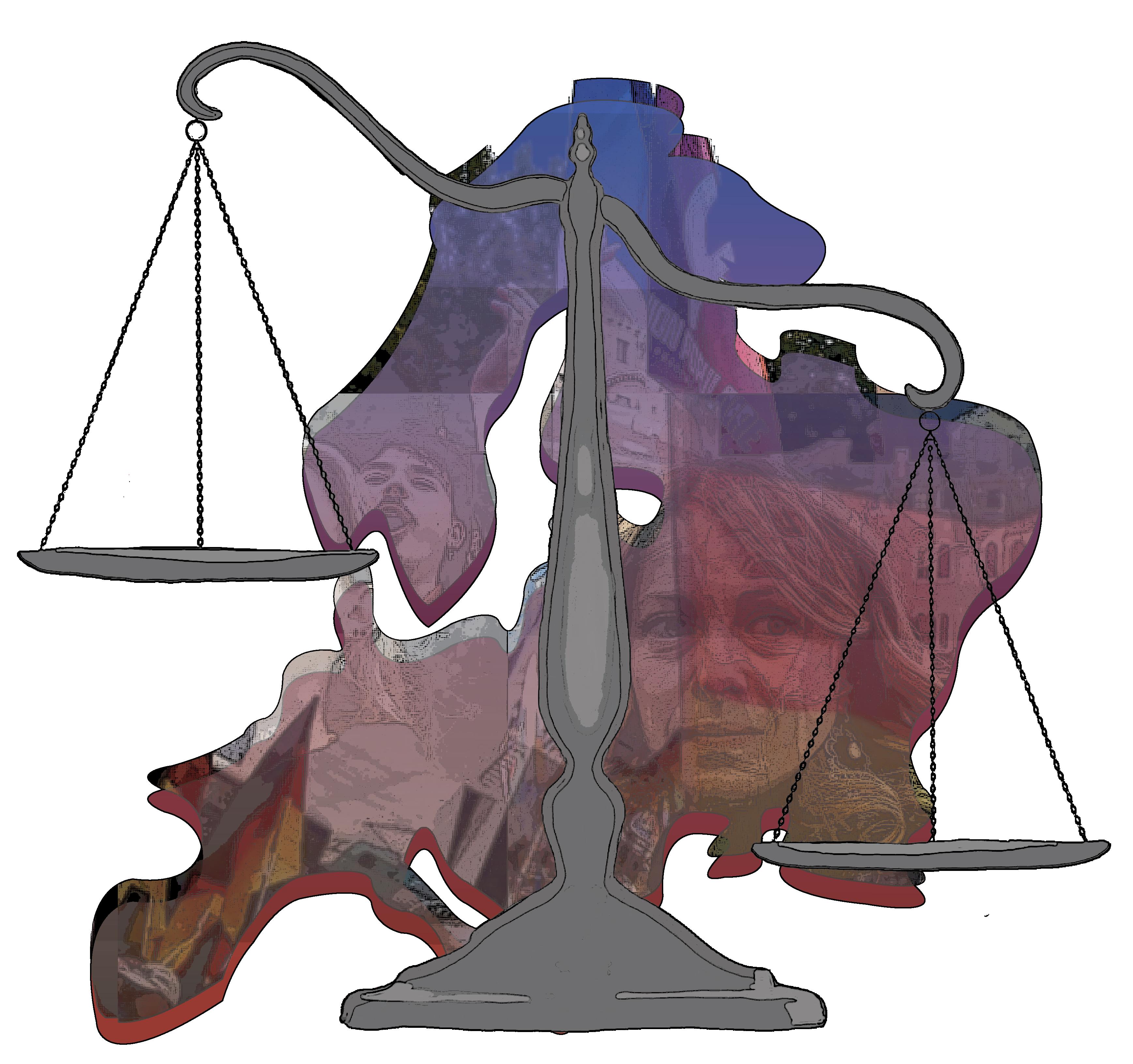
The Institution of the European Union
Europe has a long, rich history as one continental body, but the socio-political makeup of each country varies greatly. The United States is a mere 250 years old, but in contrast, the history of each respective European country has its own unique identity dating back thousands of years. Consequently, politics and tradition have never been linear, making the current socio-political climate of Europe diverse and unique.
The European Union did not become an official organization until the early 1990s. Many countries were openly ruled by the Soviets and did not gain their sovereignty until the Soviet Union fell, or unless they had a revolution against the Soviets, in the case of Hungary in 1957. The EU was solidified in this new quasi-democratic institution with the adoption of the Euro in 1999. An active executive branch, called the EU Commission, is in charge of proposing and electing laws and running the Union day by day.
According to the Council of Foreign Relations, the EU Parliament acts in the interests of the citizens, but only by political party affiliation and not necessarily by the country they were elected from.
The EU Parliament is not made up of representatives from individual countries like Spain or Italy, unlike in the U.S., where representatives act on behalf of each state. Instead, people in each country elect representatives based on their political affiliation, and then in turn, that political affiliation is translated into the overall political ideologies represented in the EU Parliament.
The Brothers of Italy is a far-right party in Italy that won in the June election. This group shares roughly the same ideology as the far-right party in Germany, the Alternative for Germany (AfD). However, where the Brothers of Italy are represented by the European Conservatives and Reformists party in the EU Parliament, AfD is represented by the Europe of Sovereign Nations party.
The most recent election in the EU occurred in May of 2024 and showed the far-right and socialist parties in Spain making a significant gain. The far-right party won Italy and Germany — which has not occurred since Adolf Hitler’s reign that ended in 1945. France called a snap election that did not work out in far-right President Emmanuel Macron’s favor, allowing the leftist party, the New Popular Front, to win France. Far-right parties across Europe took over many seats in the European Parliament that the Social Democrats previously controlled this summer. The European People’s Party gained nine seats from the previous election, putting them at 188 seats out of the 720 seats in parliament. The center-right group pushed fiscal monetary policies, transparency and surveillance in financial markets and promoted a more homogenous European way of life.
We must stay at peace with other countries at the moment because, behind our borders, we have got the war [with Russia.]
MALGORZATA GROMADZKA, MEMBER OF POLAND’S CIVIL PARTY PLATFORM
Their platform also included a variety of individual political parties from each respective country — one of them being the Brothers of Italy. The election also brought a whole new political party to the European parliament, that being the Europe of Sovereign Nations. This group is known to be a more radical incarnation of right-wing politics in Europe. They push many agendas relating to nationalism, anti-immigration, anti-Semitic and neo-fascist ideology. Within this group lies the AfD.
The political climate of the EU is so shaken up because of Europe’s deep-rooted history of socialism, and conversely, extremely pro-right-wing nationalism.
Europe’s history is long, complex and rich with technological and political innovation with the 20th century being marked by extreme nationalism in countries like Italy and Germany. With that in mind, it is no surprise that the Members of Parliament (MEPs) are anxious about the right’s rise to power.
Giorgia Meloni has led this party since 2014, and even before its contemporary form that was founded in 2012, it has deep roots in the Italian Socialist Movement, formed by former members of Mussolini’s fascist party after the war.
According to an article from Euro Prospects, the far-right party in Italy mirrors the MAGA movement in the United States. The Brothers of Italy slogan is “God, Fatherland, Family,” which seeks to trace back Italy’s roots in traditional family and social practices.
Piotr Strach, a member of Parliament for the Republic of Poland, and his other MEPs are severely concerned about the rise of nationalism and right-wing extremism in neighboring countries like Russia and Germany. His fears start at the Poland-Ukraine border, where they are currently working with other coalitions to create defensive border security strategies to eliminate the threat that Russia poses.
“The Russians took Crimea and Donbas,” Strach said. “Many people died there. Many people escaped from Ukraine.
So changes in Poland happened that we started to think about security.”
Strach said this was one of the main reasons why he sought to become a member of Parliament. He is a member of Poland 2050, which seeks to promote economic freedom and security while fighting for civil rights.
Malgorzata Gromadzka, another MEP and member of Poland’s Civil Party Platform, also mentions that national security is a national priority.
“We must stay at peace with other countries at the moment because, behind our borders, we have got the war [with Russia],” she said.
Within the United States, many talks surrounding the state of international affairs and security were placed on hold until there was a new president elected. Since the results, it is unknown where the new Trump Administration will take things.
“The reason why they grew in popularity were the knife attacks in Germany,” Gormadzka said.
She explained that these attacks were thought to be done by illegal immigrants. Members of AfD saw this as an opportunity to use the immigrants as a scapegoat, furthering the agenda that pure-blooded Germans were superior. AfD does not currently possess a majority in the German parliament and has very little control in the European parliament, Gormadzka claimed that “there’s still a safe distance between us.”
The future of European politics remains unknown for a multitude of reasons, including the new Trump Administration in the U.S.
Citizens across Europe have been startled by the rise of the far right. Consequently, the U.S. has continually been a monumental figure in delegating between these foreign adversaries, and in that, it is clear that there is an underlying hope America will not turn to far-right radicalism as seen in Germany and Italy despite the results of the 2024 Election.
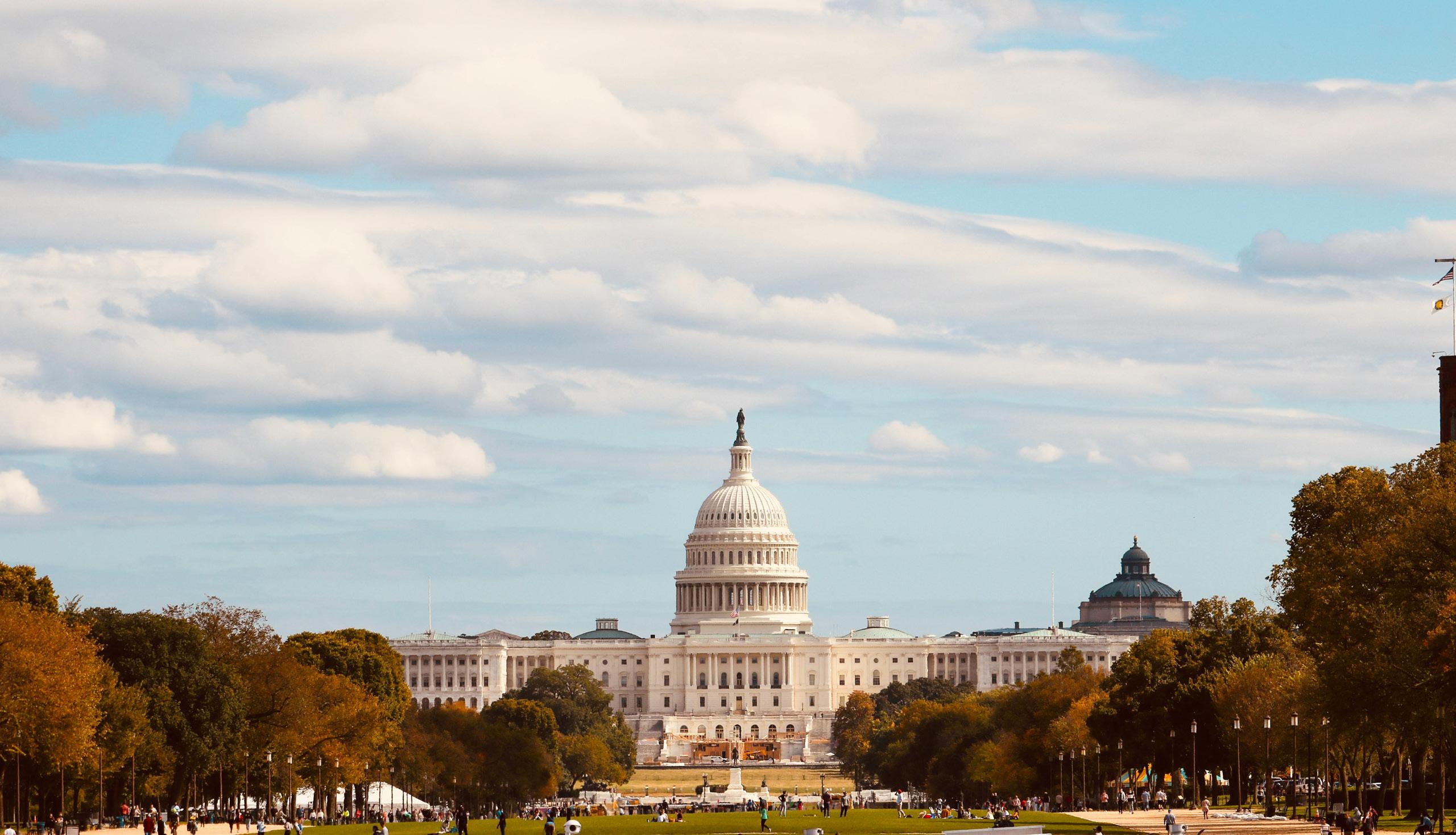




The Harkin Institute offers two types of scholarships, available to undergaduate, graduate and law students.
These scholarships were designed to expose students to policymakers and the policymaking process, much like Senator Harkin experienced as an intern for Congressman Neal Smith in the summer of 1969, an experience that inspired him to pursue a career in public service.
The scholarships’ stipends cover the recipient’s housing accommodations for the Summer, Spring, or Fall semester with Washington Intern Student Housing (WISH), a non-refundable room deposit, as well as travel expenses as outlined by Drake’s travel expense policies. Funds will be paid directly to the third party.
Applications are now accepted on a rolling basis! The Summer 2025 Deadline is April 1, 2025.

Scan QR code for more information and the application, or go to: bit.ly/THIscholarships
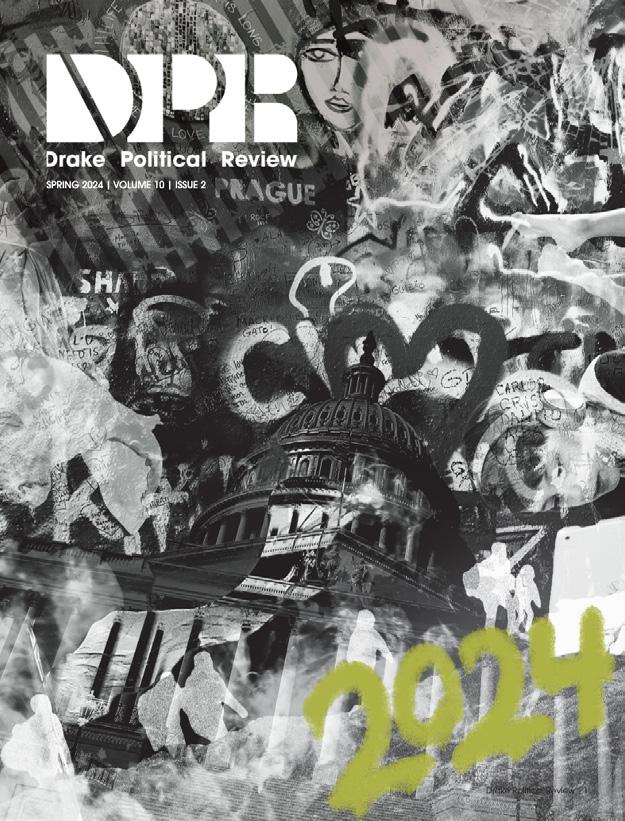

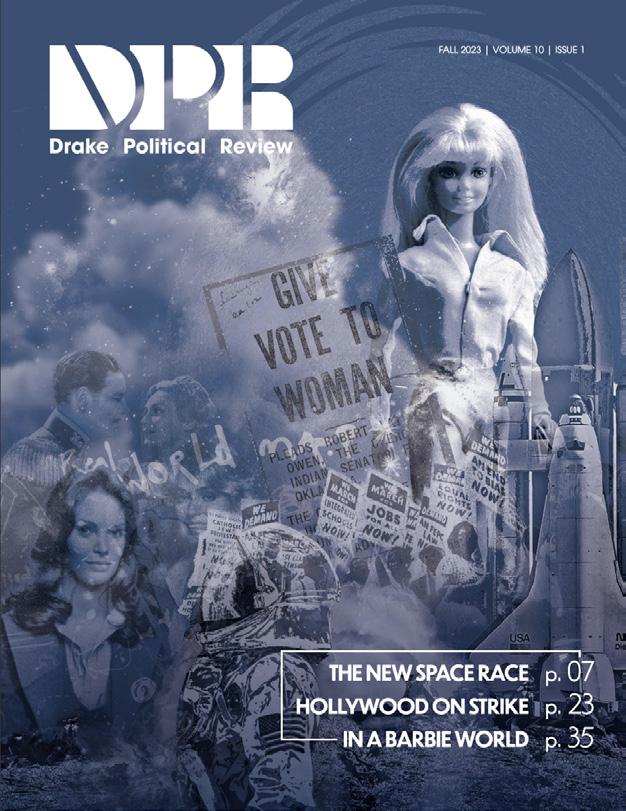



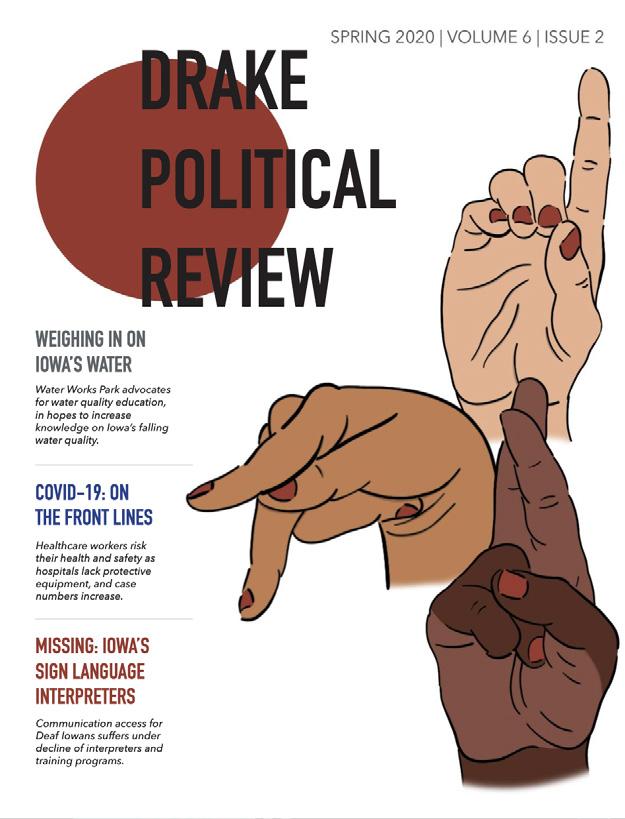

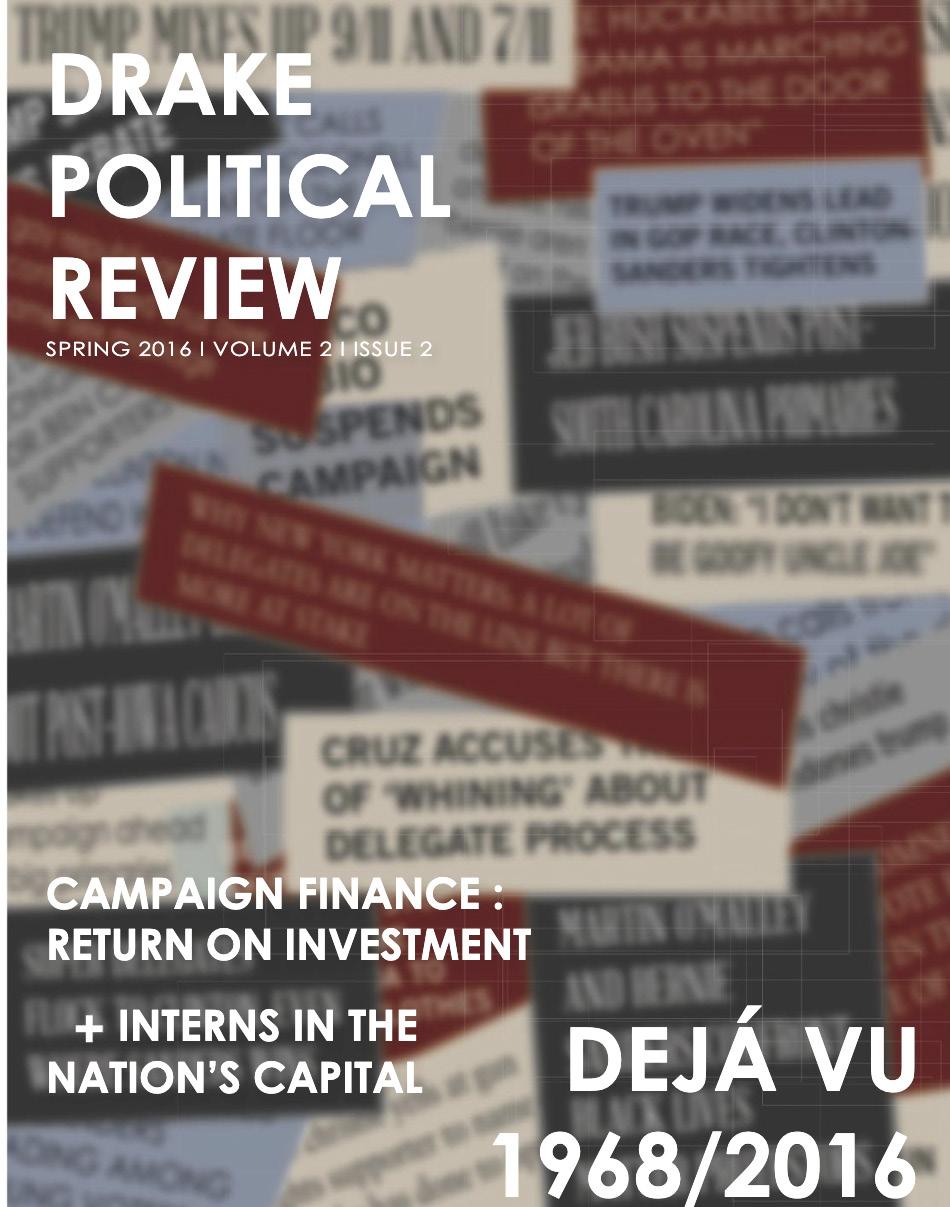

JOIN OUR MAILING LIST JOIN OUR EMAIL LIST
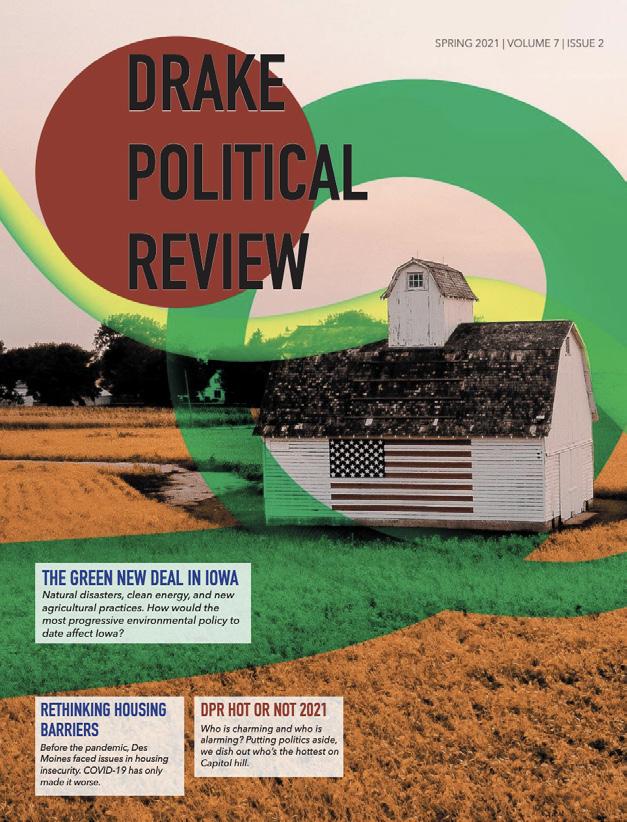
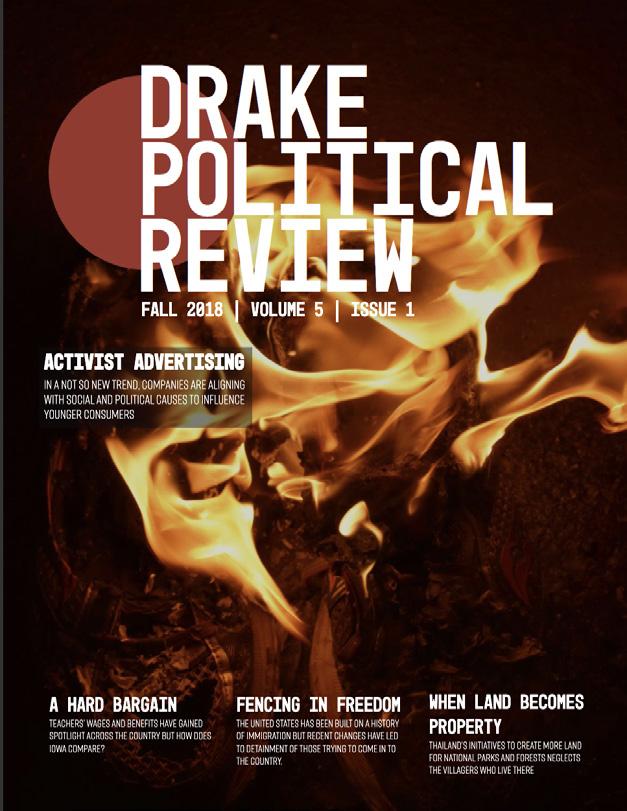
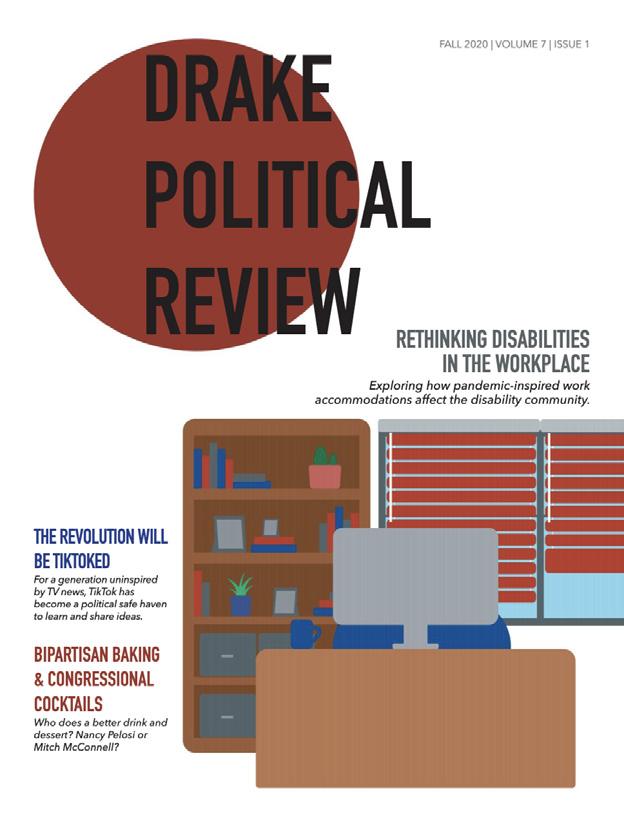
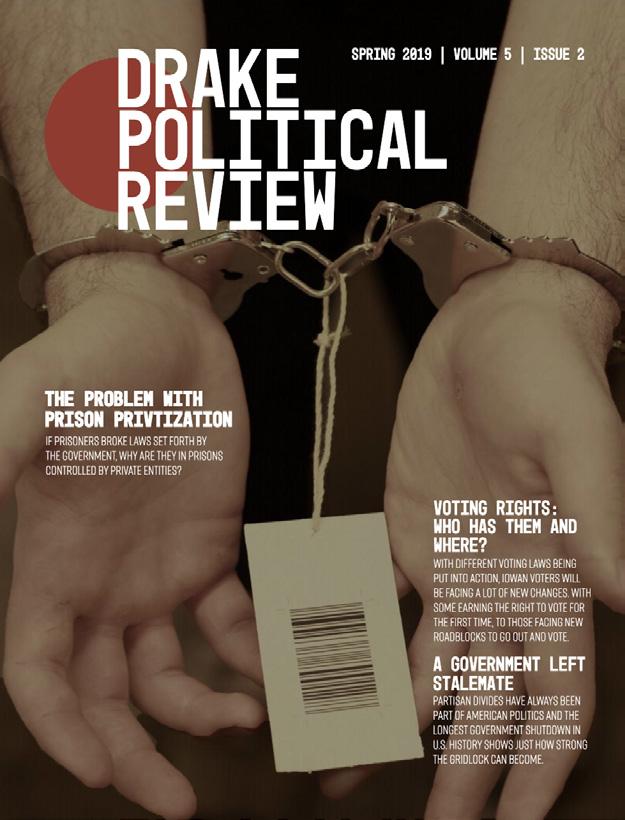

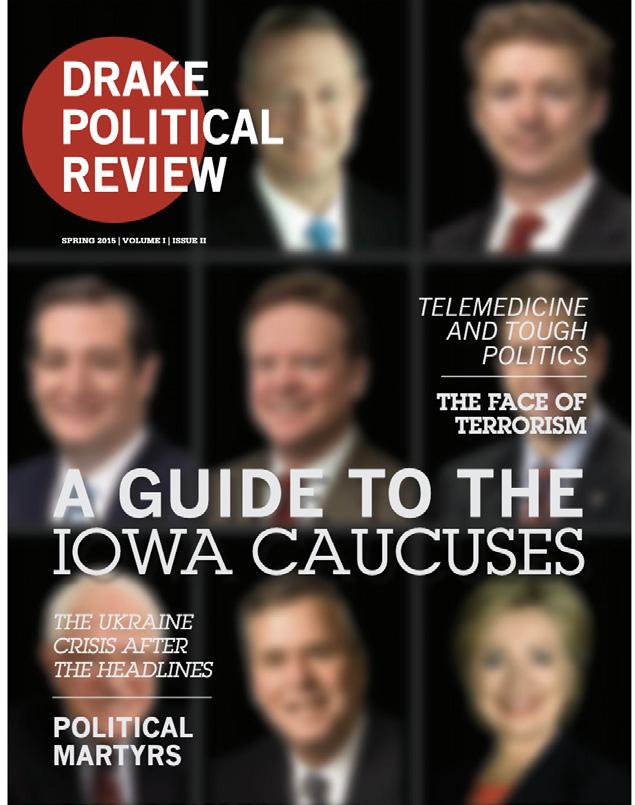
KEEP UP WITH OUR MAGAZINE AND LEARN ABOUT WRITING AND DESIGN OPPORTUNITIES BY FOLLOWING US ON INSTAGRAM: @DPRMAGAZINE
